The ultimate challenge of reefkeeping is the closing of our captive animals’ life cycles. A fortunate few have witnessed a coral spawning in their aquariums and might be interested in what it would take to raise coral planula larvae. On the other hand, there may be dedicated hobbyists interested in captive spawning of a certain species. It is the goal of this series to assist those hobbyists. This time, we’ll examine reproductive habits of stony corals. Information on the reproductive habits of over 300 stony coral species (in almost 100 genera) is presented. It is the most complete single-source reference currently available. This article will begin to offer information other factors (puberty age and size, life spans, etc.) and should begin to answer questions hobbyists might have.

Figure 1. A female Sandalolitha robusta specimen spawns at the Waikiki Aquarium. Photo courtesy Dr. Bruce Carlson.
Witnessing coral reproduction, especially in an aquarium, is an exciting event. The first inclination is usually to find the camera and document the event. In the rush, some details may be (and often are) left unrecorded. Afterwards, many questions will inevitably arise. See the Figure 51 at the end of this article for suggestions on what to record.
There are several reasons why we don’t hear of corals’ sexual spawning in captivity, and the most likely reason is that few, if any, aquarists have specially tried to address issues pertinent to success. Another reason is that spawning events are simply not observed. It is also a fact that only a handful of dedicated aquarists have sufficiently researched requirements for captive breeding.
The goals of this third article on coral reproduction are simple. We’ll examine the information available on stony coral sexuality and reproductive habits. This, in turn, will allow us to decide how many corals we’ll likely need in order to have a pair (if necessary!). Sexual maturity is another issue. Unfortunately, we can not always judge the reproductive fitness of a coral simply by examining colony size – other factors are sometimes important (colony thickness is an important diagnostic tool in some small encrusting corals).
Be aware that benthic marine invertebrates as a group utilize almost every reproductive strategy imaginable, ranging from parthenogenesis (suggested by researchers to possibly occur in a few coral taxa) to other asexual means (including ‘popping’, ‘dripping’, ‘budding’, fragmentation, transverse fission, longitudal fission, stoloniferous growths, etc.) and, of course, sexual reproduction including broadcast spawning and brooding (both internally and externally). As usual, nature will continue to confound us as we realize that a particular coral species reproductive habit can, and often does, vary according to location and/or environmental conditions. However, this should not prevent us from reviewing reproduction data gathered from over 400 references (a complete reference list will appear at the end of this series).
To recap, our goals for this time are:
- Discuss tools to ID your stony coral to the species level.
- Understand its mode(s) of reproduction and with this information select the number and size of specimens to ensure a pair exists.
- Enable you to select an appropriate aquarium size. (Be aware that many corals’ size at puberty might make them much too large for some home aquaria.)
Before continuing, perhaps a review is in order of terminology we’ll use.
Glossary
- Brooding or Brooder – Brooding
- Where fertilized eggs are held internally (or sometimes on the surface of a parent colony) and are released as planula larvae. Brooder: A coral that uses the brooding reproductive process.
- Fecundity
- Fertility; ability to produce abundantly.
- Gonochoric
- Possessing distinct male and female colonies where offspring are a result of fusion of gametes. Also referred to as dioecious, or unisexual. Gonochorism occurs in ~25% of coral species examined (Richmond, 1997).
- Hermaphroditic
- Possessing both male and female reproductive organs, sometimes referred to as monoecious. Self-fertilization (also called ‘selfing’) is an uncommon hermaphroditic trait among corals.
- Oocyte
- An immature egg (ovum).
- Parthenogenesis
- Development of a new individual from an unfertilized egg. This results in a female clone and is thought to occur in many invertebrates (including soft corals, gorgonians and possibly stony corals) and some vertebrates.
- Planula larvae
- The free-swimming, ciliated stage of coral larvae.
- Polyspermy
- Where more than one sperm fertilizes an ovum.
- Protandrous hermaphrodite
- Where male sex organs mature before those of the female.
- Protogynous
- (proto=first; gynous = female) – Where female sex organs mature before those of the male.
- Self-fertilization or ‘Selfing’
- Where gametes from a single parent colony are sufficient for successful reproduction. Relatively uncommon.
An Initial Recommendation
Unless you’ve witnessed a spawning of a particular coral species within your aquarium and want to investigate further, it is probably best to choose a coral that utilizes the brooding strategy. There are many advantages:
- Brooding coral species are generally smaller in size than their broadcasting counterparts.
- Planula larvae from brooders are relatively mature upon release and have the advantage of size.
- Some hermaphroditic brooders do not broadcast gametes. This lessens the chance of the aquarium’s life support system suffering catastrophic failure.
- Brooded larvae sometimes contain zooxanthellae upon release from the parent colony, and the larvae do not have to obtain them from the surrounding environment.
Suspected Parthenogenesis
Parthenogenesis (definition above) is known to occur in a few invertebrates and even some vertebrates. It is suspected to occur in these stony corals:
- Pocillopora damicornis (Permata et al., 2000)
- Porites lobata (Fadllalah, 1983)
- Porites lutea (Fadllalah, 1983)
- Fungia scutaria (Krupp, 1983)
Self-fertilization (‘selfing’)
- Acropora (Isopora) brueggemanni (Okubo et al., 2007)
- Acropora tenuis (Heyward and Babcock, 1986)
- Agaricia agaricites (Gleason et al., 2001).
- Balanophyllia europaea (Goffredo et al., 2005).
- Diploria strigosa (Hagman et al., 1998, in Alvarado et al., 2003)
- Favia fragum (numerous references)
- Goniastrea aspera (Heyward and Babcock, 1985)
- Goniastrea favulus (Stoddart et al., 2004; Miller & Mundy, 2005)
- Mycetophyllia species, suspected (Tirado, 2006)
- Pocillopora damicornis (numerous references)
- Porites astreoides (Gleason et al., 2001).
- Seriatopora hystrix (Sherman, 2008)
- Siderastrea radians (Neves et al., 2008)
- Tubastraea coccinea (numerous references)
Gonochoric Brooding
Gonochoric brooding involves broadcast spawning by males and internal or external (surface) fertilization of oocytes, followed by internal or surface brooding:
- Balanophyllia regia (Goffredo et al., 2005)
- Dendrophyllia sp. (Babcock et al., 1986)
- Goniopora queenslandiae (Yamazato et al., 1975, in Fadlallah, 1983)
- Isophyllia dipsacea (Duerden, 1902, in Fadlallah, 1983)
- Leptopsammia pruvoti (Kruzic et al., 2008)
- Porites brighami (Richmond & Hunter, 1990)
- Porites clavaria (Fadlallah, 1983)
- Porites furcata (Soong, 1991)
- Porites murrayensis (Neves, 1998)
- Porites panamensis (Glynn et al., 2008)
- Scolymia wellsi (suspected; Pitombo, 1992)
- Tubastraea faulkerni (Babcock, 1986)
Brooders (stony corals)
- Acrhelia horrescens (Kawaguti, 1941)
- Acropora (Isopora) brueggemanni (see Richmond & Hunter, 1990)
- Acropora corymbosa (Stimson, 1978)
- Acropora (Isopora) cuneata (Wallace et al., 2007)
- Acropora humilis (Stimson, 1978)
- Acropora palawensis (see Richmond & Hunter, 1990)
- Acropora (Isopora) palifera (Kojis, 1986)
- Acropora striata (Stimson, 1978)
- Acropora (Isopora) togianensis (Wallace et al., 2007)
- Agaricia agaricites (Thornhill et al., 2006)
- Alveopora daedalea (Schlesinger & Loya, 1985)
- Balanophyllia europaea (Mezzomonaco et al., 2002)
- Caryophyllia cyathus (Koch, 1897)
- Cyphastrea ocellina (Stimson, 1978)
- Dendrophyllia manni (see Richmond & Hunter, 1990)
- Diploria strigosa (Hagman et al., 1998)
- Euphyllia glabrescens (Kawaguti, 1941)
- Favia fragum (Szmant, 1986)
- Galaxea aspera (see Richmond & Hunter, 1990)
- Goniopora queenslandiae (Loya, 1976)
- Heliofungia actiniformis (see Richmond & Hunter, 1990)
- Isophyllia dipsacea (Fadllalah, 1983)
- Isopora togianensis (Wallace et al., 2007)
- Madracis carmabi (Vermeij et al., 2004)
- Madracis decactis (Vermeij et al., 2004)
- Madracis formosa (Vermeij et al., 2004)
- Madracis mirabilis (Vermeij et al., 2004)
- Madracis pharensis (Vermeij et al., 2004)
- Madracis senaria (Vermeij et al., 2004)
- Manicina areolata (Johnson, 1992)
- Mycetophyllia ferox (Babcock et al., 1986)
- Pocillopora damicornis (Stimson, 1978)
- Pocillopora elegans (Stimson, 1978)
- Pocillopora verrucosa (Stimson, 1978)
- Porites astreoides (Thornhill et al., 2006)
- Porites panamensis (Glynn et al., 2008)
- Scolymia wellsi (Pitombo, 1992)
- Seriatopora caliendrum (Rinkevich & Loya, 1979)
- Seriatopora hystrix (multiple references)
- Siderastrea radians (Thornhill et al., 2006)
- Tubastraea coccinea (Glynn et al., 2008)
Protandrous and Protogynous Hermaphrodites
Protandrous Hermaphrodites
- Flabellum rubrum (Moseley, 1881, in Fadlallah, 1983)
- Goniastrea favulus (Kojis and Quinn, 1981)
- Stylophora pistillata (Loya, 1976)
Protogynous Hermaphrodite
- Siderastrea radians (Duerden, 1902, in Fadlallah, 1983)
Degree of Difficulty
As we have seen, aquarists have been successful in propagating a number of coral species. There are a number of factors involved in these successes, beginning with the skill and dedication of the aquarist. Seasoned veterans often report ‘easy’ asexual reproduction of species difficult to maintain long-term in captivity (some Goniopora species are good examples, while there are no reports of reproduction of easily maintained species).
With that said (and avoiding the issues and degrees of difficult in husbandry of some coral species), I will unilaterally list my perception of how challenging captive breeding of corals could be (beginning with the least difficult):
- Those capable of Parthenogenesis.
- Programmed fragmentation. This method is essentially left to the coral (it is genetically programmed to produce colonies in this manner), and fragments ‘drip’ or ‘pop’ away. The only thing required from the hobbyist is securing the cloned colony to a suitable substrate.
- Intentional fragmentation. This technique requires little from the hobbyist. Small fragments, or nubbins, or snipped, clipped, sliced or cut away from brood stock and attached to any of a number of substrates for grow-out.
- Brooding coral colonies capable of self-fertilization or ‘selfing’. Since ‘selfing’ is due to fertilization of an egg produced by a female by a sperm produced by a male within the same colony or sometimes the same polyp (hermaphroditic), these bisexual coral colonies can reproduce with only one colony present.
- Hermaphroditic brooding corals.
- Hermaphroditic broadcast spawners. In theory, only two coral colonies would be required to ensure cross-fertilization. However, many variables come into play such as sperm concentrations, polyspermy, egg buoyancy, impact of spawning on aquarium water quality, mode of zooxanthellae acquisition (vertical or horizontal), etc.
- Gonochoric broadcast spawners. In addition to the challenges presented by hermaphroditic broadcast spawners (above), we have to consider sex ratios (sometimes heavily skewed towards males) and the impact this has on sizing the aquarium.
Comments on Data Bases
While research this article, I found it best to maintain two data bases, and both are presented in this article. First, reproductive information about stony corals is listed in taxonomic order – by Family, Genus and Species along with comments, photographs, etc. After that, a quick reference sheet (along with the reference) presents reproductive information sans photos and comments (See Table 108).
A Note on Caribbean Corals
There have been rumors for a number of years that Caribbean corals would become legally available to hobbyists. After a number of false starts, this seems to be a reality. Rose corals (Manicina areolata) are available, and Siderastrea species may soon follow (Michael Janes, personnel communication. See www.aquatouch.com for details). Acropora palmata spats (grown from legally collected eggs and sperm from spawn slicks) are now in public aquaria. Perhaps this endangered species will someday be in home reef aquaria.
It has been estimated that 60% of Caribbean corals are brooders; some are of relatively small size and may be available in the future. For these reason, I have included Caribbean species in this article.
The Aquarium
Almost every article written on home-based fish propagation begins with aquarium selection. So, it is seems reasonable to start there, right? “Let’s see – I’ve got that old 40 gallon breeder tank just gathering dust. I could use it…”
Whoa, cowboy! This line of reasoning has already dismissed the idea of logically thinking this project through from concept to reality. Fish breeders can choose the correct aquarium because they know much more about their fishes’ reproductive habits than coral farmers know about their corals’. It is fairly easy to quickly research size of adult fish and how to sex them. So, let’s start over.
Selecting Your Coral
Before you select your candidate coral, you should be able to identify it. There is a great deal of published research available (some of it presented in this series of articles), but utilization of this information depends upon correct identification of the coral. In some cases and with enough experience, this is simple. Some corals, such as the Elegance coral (Catalaphyllia jardineri), are not easily confused with any other species. Other corals will demonstrate a plasticity in shape and appearance according to environmental factors (water motion and lighting being two major influences), or naturally resemble very closely another coral species. For instance, there are several Acropora species that have pronounced corallites that appear to the casual viewer to be Acropora millepora, when in fact they are not.
Coral Identification Resources
Coral ID Software
Unless your stony coral identification skills are well-honed, I recommend the purchase of Veron’s Coral ID software. See the Media Review on this excellent resource for stony coral species identification here (http://www.advancedaquarist.com/2008/4/review ).
Internet Resources
For Acropora species, there is an excellent free resource on the internet (www.coralsee.org).
Veron’s Corals of the World is available for free at this website: http://whelk.aims.gov.au/coralsearch/coralid-search.php
Note this website is easier to use if you already know the coral ID to genus level. Then it is a matter of looking at each species. This can be a time consuming matter, and definitely is not as easy to reference as the print version.
If getting an ID to the genus level is acceptable, see CoralIdea (www.coralidea.com).
Books
There is no better book than Veron’s Corals of the World (2000). See the review of this book here (http://www.advancedaquarist.com/2008/4/review).
With a little practice and a few basic laboratory tools (magnifying glass, dissecting microscope) you should be able to get a reasonable idea as to the correct species (it helps if you know where the corals were collected – keep this in mind if you order through any of the major distributors. They know!).
Can I Use Fragments? Effect of Damage (Fragmentation) on Fecundity

Figure 2. Anatomy of a ‘typical’ stony coral polyp. Eggs (oocytes) and spermaries (male gonads) – either separately or together – can be found on mesenteries within sexually mature polyps.
It is generally believed that growth, reproduction and maintenance are processes competing for a limited amount of energy. The effects of breakage on a particular colony depend upon the amount of damage, colony size, energy reserves (such as lipids), environmental conditions and other factors. Limited resources could be devoted to repair traumatized areas. It is also possible that corals will re-absorb oocytes/eggs to obtain their high-calorie yolks for use in tissue repair.
There are several published papers on the subject. Zakai (1997) found that breakage of Pocillopora damicornis exceeding 25% of colony area reduced planulation by 63% while having no effect on the size (but obviously the number) of planulae. Smith and Hughes, 1999 examined the effects of breakage on Acropora intermedia, Acropora millepora, Acropora hyacinthus and found that fecundity was greatly reduced.
However, fragmentation does not necessarily reduce fecundity. Daughter colonies produced by programmed fragmentation by Diaseris distorta are sexually functional at sizes as small as 1 cm2 (roughly ½” square). See Part 1 of this series for photos of Diaseris.
In general, fragments can be used, but expect fecundity to be reduced or delayed.
Polyp Anatomy
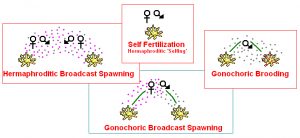
Figure 3. Modes of coral reproduction. ‘Selfing’ and ‘gonochoric brooding’ are relatively uncommon, while the two forms of broadcast spawnings are not.
The sexual organs of corals are usually on mesenterial filaments within the polyp. See Figure 2.
Sexing Your Coral
After selecting your target species, we can continue. Unfortunately, you can’t just look at a coral and determine if it is male or female (unless you have the good fortune to witness it in the act of spawning, or have a small laboratory devoted to histology and can examine coral gonads). We’ll need to understand a couple of terms before we continue.
Spawning Ratios – How Many of Each Species in an Aquarium?
Most corals are hermaphroditic and only in relatively few cases do we have to concern ourselves with the issue of sex ratios. Sex ratios, when available, are included in the initial reports (below). Be aware that sex ratios are not fixed and can vary from location to location, but this is the best information we currently have.
Notes on Colony Size, Sexual Maturity and Life Span
Colony size and sexual maturity has been linked in some cases, but many factors other than colony area should be considered. In some cases, it is not the size of the colony but the thickness of the coral’s encrustation over the substrate that is the telling factor. In other cases, corals can asexually reproduce by fission, where a portion of the colony becomes isolated from the parent. In some cases, total mass of the colony (such as gorgonians) should be considered in lieu of colony height.
Generally, corals are a long-lived bunch and it is not uncommon to hear reports of corals believed to be hundreds of years of age. However, local patterns (number of storms, temperature, anthropogenic impacts, etc.) can limit survival rates.
On the other hand, brooding corals tend to have relatively brief lives. They mature at an earlier age and smaller size. They produce fewer young, but these tend to be well developed with a higher chance of survival. In some cases, brooders are opportunistic colonizers.
We’ll now begin our review of stony coral reproductive habits. They are listed by in alphabetical order by Family, followed by Genus (also in alphabetical order). Information on species is presented in any of the Tables and some of the Figures.
For those wanting a quick reference, see the end of this article for Table 108 – The Quick and Easy Reference. There, corals are listed alphabetically by Genus.
Family Acroporidae
Genus Acropora (Staghorn and Antler Corals)

Figure 4. Acropora species are easily propagated via intentional fragmentation by hobbyists, but there are reports of sexual spawning in aquaria. Photo by the author.
| Taxon | Sexuality | Reproduction |
|---|---|---|
| Acropora aculeus | Hermaphroditic | Broadcast |
| Acropora acuminata | Broadcast | |
| Acropora anthoceris | Hermaphroditic | Broadcast |
| Acropora aspera | Hermaphroditic | Broadcast |
| Acropora austera | Hermaphroditic | Broadcast |
| Acropora caroliniana | Broadcast | |
| Acropora cerealis | Hermaphroditic | Broadcast |
| Acropora cervicornis | Hermaphroditic | Broadcast |
| Acropora clathrata | Hermaphroditic | Broadcast |
| Acropora corymbosa | Hermaphroditic | Brooder |
| Acropora cytheria | Hermaphroditic | Broadcast |
| Acropora danai | Hermaphroditic | Broadcast |
| Acropora delicatula | Possibly sterile | |
| Acropora delicatula | See Acropora selago | Broadcast |
| Acropora digitifera | Hermaphroditic | Broadcast |
| Acropora dilitata | Hermaphroditic | Broadcast |
| Acropora divaricata | Hermaphroditic | Broadcast |
| Acropora donei | Hermaphroditic | Broadcast |
| Acropora elseyi | Broadcast | |
| Acropora eurystoma | Hermaphroditic | Broadcast |
| Acropora exquisita | Hermaphroditic | Broadcast |
| Acropora florida | Hermaphroditic | Broadcast |
| Acropora formosa | Hermaphroditic | Broadcast |
| Acropora gemmifera | Hermaphroditic | Broadcast |
| Acropora glauca | ? | Broadcast |
| Acropora grandis | Hermaphroditic | Broadcast |
| Acropora grandulosa | Hermaphroditic | Broadcast |
| Acropora hemprichii | Hermaphroditic | Broadcast |
| Acropora horrida | Hermaphroditic | Broadcast |
| Acropora humilis | Hermaphroditic | Broadcast |
| Acropora humilis | ? | Brooder |
| Acropora hyacinthus | Hermaphroditic | Broadcast |
| Acropora hystrix | Hermaphroditic | Broadcast |
| Acropora intermeda | Broadcast | |
| Acropora irregularis | Hermaphroditic | Broadcast |
| Acropora jacquelineae | Broadcast | |
| Acropora kimbeensis | ||
| Acropora “kosurini-like” | Broadcast | |
| Acropora latistella | Hermaphroditic | Broadcast |
| Acropora lianae | Broadcast | |
| Acropora listeri | Broadcast | |
| Acropora longicyathus | Hermaphroditic | Broadcast |
| Acropora loripes | Hermaphroditic | Broadcast |
| Acropora lutkeni | Hermaphroditic | Broadcast |
| Acropora microclados | Hermaphroditic | Broadcast |
| Acropora microphthalma | Hermaphroditic | Broadcast |
| Acropora millepora | Hermaphroditic | Broadcast |
| Acropora monticulosa | Hermaphroditic | Broadcast |
| Acropora muricata | Hermaphroditic | Broadcast |
| Acropora nana | Hermaphroditic | Broadcast |
| Acropora nastua | Hermaphroditic | Broadcast |
| Acropora nobilis | Hermaphroditic | Broadcast |
| Acropora ocellata | Hermaphroditic | Broadcast |
| Acropora palawensis | ? | Brooder |
| Acropora palmata | Hermaphroditic | Broadcast |
| Acropora palmerae | Broadcast | |
| Acropora papillare | Broadcast | |
| Acropora plumosa | Broadcast | |
| Acropora polystoma | Broadcast | |
| Acropora pulchra | Hermaphroditic | Broadcast |
| Acropora robusta | Hermaphroditic | Broadcast |
| Acropora samoensis | Hermaphroditic | Broadcast |
| Acropora sarmentosa | Hermaphroditic | Broadcast |
| Acropora scandens | Hermaphroditic | Broadcast |
| Acropora secale | Hermaphroditic | Broadcast |
| Acropora selago | Hermaphroditic | Broadcast |
| Acropora smithi | Hermaphroditic | Broadcast |
| Acropora solitaryensis | Hermaphroditic | Broadcast |
| Acropora spathulata | Broadcast | |
| Acropora spicifera | Broadcast | |
| Acropora squarrosa | Hermaphroditic | Broadcast |
| Acropora striata | ? | Brooder |
| Acropora subulata | Broadcast | |
| Acropora surculosa | Hermaphroditic | Broadcast |
| Acropora tenuis | Hermaphroditic | Broadcast |
| Acropora tortuosa | Hermaphroditic | Broadcast |
| Acropora valenciennesi | Hermaphroditic | Broadcast |
| Acropora valida | Hermaphroditic | Broadcast |
| Acropora variabilis | Hermaphroditic | Broadcast |
| Acropora vaughani | Broadcast | |
| Acropora verweyi | Hermaphroditic | Broadcast |
| Acropora willisae | Broadcast | |
| Acropora yongei | Hermaphroditic | Broadcast |
Puberty Age for Acropora Species
Wallace (1985) estimates Acropora granulosa, A. hyacinthus, A. loripes and A. valida first spawn when they are 4-5 years of age. See Table 2 for more information.
| Taxa | Puberty Size | Age | Reference |
|---|---|---|---|
| Acropora spp. | >20cm | Guest et al., 2005 | |
| Acropora spp. | 3 years | Harrison & Wallace, 1990 |
Subgenus Isopora
Some controversy exists over ‘subgenus’ status of Isopora (some feel it should be elevated to genus status), but I’ll present information as subgenus -as it is listed in the references – until this matter is resolved.
| Taxon | Sexuality | Reproduction |
|---|---|---|
| Acropora (Isopora) brueggemanni | Hermaphroditic | Brooder |
| Acropora (Isopora) cuneata | Hermaphroditic | Brooder |
| Acropora (Isopora) palifera | Hermaphroditic | Brooder |
| Acropora (Isopora) togianensis | Hermaphroditic | Brooder |
Genus Anacropora
| Taxon | Sexuality | Reproduction |
|---|---|---|
| Anacropora matthai | Broadcast |
Genus Astreopora
| Taxon | Sexuality | Reproduction |
|---|---|---|
| Astreopora gracilis | Broadcast | |
| Astreopora listeri | Broadcast | |
| Astreopora myriophthalma | Hermaphroditic | Broadcast |
| Astreopora randalli | Hermaphroditic | Broadcast |
Genus Montipora
Montipora species are very popular among reef hobbyists and for good reason. As a group, they are hardy and can grow quickly. In addition, some species contain colorful fluorescent and chromoprotein pigments (see Figure 5).
| Taxon | Sexuality | Reproduction |
|---|---|---|
| Montipora aequituberculata | Hermaphroditic | Broadcast |
| Montipora altasepta | Hermaphroditic | Broadcast |
| Montipora cactus | Hermaphroditic | Broadcast |
| Montipora capitata | Hermaphroditic | Broadcast |
| Montipora crassituberculata | Hermaphroditic | |
| Montipora digitata | Hermaphroditic | Broadcast |
| Montipora dilatata | Hermaphroditic | Broadcast |
| Montipora efflorescens | Hermaphroditic | Broadcast |
| Montipora effusa | Broadcast | |
| Montipora erythraea | Hermaphroditic | Broadcast |
| Montipora eydouxi | Hermaphroditic | Broadcast |
| Montipora faveolata | Hermaphroditic | Broadcast |
| Montipora flabellata | Hermaphroditic | Broadcast |
| Montipora floweri | Hermaphroditic | Broadcast |
| Montipora foliosa | Hermaphroditic | Broadcast |
| Montipora hispida | Hermaphroditic | Broadcast |
| Montipora informis | Hermaphroditic | Broadcast |
| Montipora monasteriata | Hermaphroditic | Broadcast |
| Montipora patula | Hermaphroditic | Broadcast |
| Montipora peltiformis | Broadcast | |
| Montipora ramosa | Broadcast | |
| Montipora samarensis | Hermaphroditic | |
| Montipora spumosa | Hermaphroditic | Broadcast |
| Montipora studeri | Hermaphroditic | Broadcast |
| Montipora tuberculosa | Broadcast | |
| Montipora turgescens | Hermaphroditic | Broadcast |
| Montipora turtlenesis | Hermaphroditic | Broadcast |
| Montipora venosa | Hermaphroditic | Broadcast |
| Montipora verrilli | Hermaphroditic | Broadcast |
| Montipora verrucosa | Hermaphroditic | Broadcast |
Puberty Size of Montipora Specimens
Bassim (1997) reports that Montipora verrucosa (now M. capitata) colonies are sexually mature when they are 18 cm (7.2″) on the longest axis.
Family Agariciidae
Members of Agariciidae are a mixed bag, reproductively speaking (Veron, 1986) – Agaricia species are brooders, while Pavona species are broadcast spawners. We don’t have enough information on other genera to make generalizations. Unfortunately, there is presently a ban on collection of Agaricia species, but Pachyseris and Pavona specimens are common in reef aquaria.
Genus Agaricia(Lettuce Leaf Corals)
| Taxon | Sexuality | Reproduction |
|---|---|---|
| Agaricia agaricites | Hermaphroditic | Brooder |
| Agaricia crassa | ? | Brooder |
| Agaricia fragilis | ? | Brooder |
| Agaricia grahame | ? | Brooder |
| Agaricia humilis | Hermaphroditic | Brooder |
| Agaricia lamarcki | ? | Brooder |
| Agaricia purpurea | Hermaphroditic | Brooder |
| Agaricia tenufolia | ? | Brooder |
| Agaricia undata | ? | Brooder |
Puberty Size of Agaricia humilis
Agaricia species are found only in the Caribbean (Veron, 1986). As far as we know, all Agaricia species are hermaphroditic brooders. Agaricia humilis specimens are sexually mature when they are ~28mm in diameter (van Moorsel, 1983). A. humilis is known to planulate year round. See Figure 6 for details on adult colony sizes.
Genus Coeloseris
No information on reproductive habits available.
Genus Gardineroseris
| Taxon | Sexuality | Reproduction |
|---|---|---|
| Gardineroseris planulata | Hermaphroditic |
Genus Helioseris
| Taxon | Sexuality | Reproduction |
|---|---|---|
| Helioseris cucullata | Brooder |
Genus Leptoseris (Ridge Corals)
No information on reproductive habits available.
Genus Pachyseris
| Taxon | Sexuality | Reproduction |
|---|---|---|
| Pachyseris rugosa | Gonochoric | Broadcast |
| Pachyseris speciosa | Gonochoric | Broadcast |
Genus Pavona (Pork Chop or Corrugated Corals)
| Taxon | Sexuality | Reproduction |
|---|---|---|
| Pavona cactus | Gonochoric | ? |
| Pavona duerdeni | Gonochoric | Broadcast |
| Pavona explanata | Gonochoric (?) | |
| Pavona gigantea | Gonochoric | Broadcast |
| Pavona varians | Gonochoric | Broadcast |
Family Astrocoeniidae
Genus Madracis
Madracis species are cosmopolitan – they are found in the Pacific (including Hawaii), Atlantic and Mediterranean.
| Taxon | Sexuality | Reproduction |
|---|---|---|
| Madracis carmabi | Hermaphroditic | Brooder |
| Madracis decactis | Hermaphroditic | Brooder |
| Madracis formosa | Hermaphroditic | Brooder |
| Madracis mirabilis | Hermaphroditic | Brooder |
| Madracis pharensis | Hermaphroditic | Brooder |
| Madracis senaria | Hermaphroditic | Brooder |
Genus Palauastrea
Biologists seem to have overlooked this coral (it strongly resembles the common Porites cylindrica) and I have been unable to locate any information concerning its reproductive habits.
Genus Stephanocoenia
| Taxon | Sexuality | Reproduction |
|---|---|---|
| Stephanocoenia intercepta | Gonochoric | Broadcast |
| Stephanocoenia michelini | Gonochoric | Broadcast |
Genus Stylocoeniella
| Taxon | Sexuality | Reproduction |
|---|---|---|
| Stylocoeniella sp. | Gonochoric |
Family Caryophylliidae
Genus Heterocyathus
A zooxanthellate coral (Veron, 2000). No information is available about reproductive habits.
Genus Caryophyllia
| Taxon | Sexuality | Reproduction |
|---|---|---|
| Caryophyllia ambrosa (deep water) | Hermaphroditic | |
| Caryophyllia cornuformis (deep water) | Hermaphroditic | |
| Caryophyllia cyathus | ? | Brooder |
| Caryophyllia sequenzae (deep water) | Hermaphroditic | |
| Caryophyllia smithi | Gonochoric | Broadcast |
Genus Goniocorella
| Taxon | Sexuality | Reproduction |
|---|---|---|
| Goniocorella dumosa (deep water) | Gonochoric |
Genus Lophelia
| Taxon | Sexuality | Reproduction |
|---|---|---|
| Lophelia pertusa (deep water) | Gonochoric | ? |
Family Dendrophylliidae
Some of the members of Dendrophylliidae are non-photosynthetic (they do not contain zooxanthellae). Since they are not autotrophic, some Balanophyllia, Dendrophyllia, Tubastraea and others require good water motion to deliver enough food, or require regular feedings. Those aquarists willing to meet the demands of these often brightly colored animals are often rewarded by their corals’ captive spawnings (usually in the form of planula larvae).
Genus Balanophyllia
Balanophyllia europea (a Mediterranean coral) contains zooxanthellae. Other Balanophyllia species do not.
| Taxon | Sexuality | Reproduction |
|---|---|---|
| Balanophyllia elegans | Gonochoric | Brooder |
| Balanophyllia europaea | Hermaphroditic | Brooder |
| Balanophyllia pruvoti | Gonochoric | |
| Balanophyllia regia | Gonochoric (?) | Brooder |
| Balanophyllia sp. | Brooder |
Age of Puberty, Sex Ratio and Life Span for Balanophyllia species
Balanophyllia elegans colonies are capable of reproduction (brooding) at 1.5 years of age and have an expected life span of about 10 years (Gerrodette, 1981).
The gonochoric Balanophyllia pruvoti has a sex ratio of 1:1 (Radetic et al., 2002).
Genus Cladopsammia
| Taxon | Sexuality | Reproduction |
|---|---|---|
| Cladopsammia rolandi | Hermaphroditic | Brooder |
Genus Dendrophyllia
| Taxon | Sexuality | Reproduction |
|---|---|---|
| Dendrophyllia nigrescens | See Tubastraea spp. | |
| Dendrophyllia sp. | Gonochoric | Brooder |
Genus Duncanopsammia
No information available on reproduction of the single member of this genus – Duncanopsammia axifuga (Veron, 1986).
Genus Enallopsammia
| Taxon | Sexuality | Reproduction |
|---|---|---|
| Enallopsammia rostrata( deep water) | Gonochoric |
Genus Leptopsammia (Sunset Cup Coral)
| Taxon | Sexuality | Reproduction |
|---|---|---|
| Leptopsammia pruvoti | Gonochoric | Brooder |
Genus Heteropsammia
These small (25mm diameter) corals live at depths of ~25 meters or more and are free-living on soft bottoms (Veron, 2000). They may or may not contain zooxanthellae.
| Taxon | Sexuality | Reproduction |
|---|---|---|
| Heteropsammia aequicostatus | Gonochoric | Broadcast |
| Heteropsammia cochlea | Gonochoric | Broadcast |
Genus Rhizopsammia (Wellington’s Solitary Coral)
| Taxon | Sexuality | Reproduction |
|---|---|---|
| Rhizopsammia minuta | Brooder |
Genus Tubastraea(Sun Corals)
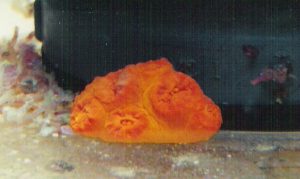
Figure 9. This Tubastraea colony originated from a planula larva that settled in an area of high flow – an overflow in a reef aquarium.
Tubastraea (or perhaps Dendrophyllia) specimens reproduce readily in an aquarium when conditions are right.
Fully developed planula larvae are released and the number of reports of this occurrence in aquaria rivals that of another brooding coral – Pocillopora damicornis.
| Taxon | Sexuality | Reproduction |
|---|---|---|
| Tubastraea aurea | See Tubastraea coccinea | |
| Tubastraea coccinea | Hermaphroditic | Brooder |
| Tubastraea faulkneri | Gonochoric | Brooder |
Puberty Size and Age of Tubastraea coccinea
Tubastraea coccinea (Glynn et al., 2008) Reproductive at 1.5 years, equating to colony size of ~5 cm in diameter, although Glynn et al., 2008 reports colonies can be reproductive when only 2 to 10 polyps are present (possibly due to stoloniferous growths). Paz-García et al. (2007) also reports reproduction in colonies only 5 cm in diameter (see Figure 11).
Genus Turbinaria (Pagoda Corals)
Veron, 1986 states that Turbinaria species are all gonochoric broadcast spawners.
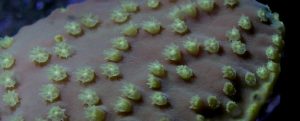
Figure 11. The distinctive yellow-green coloration of Turbinaria reniformis is visible in this specimen. Photo by the author.
| Taxon | Sexuality | Reproduction |
|---|---|---|
| Turbinaria frondens | Gonochoric | |
| Turbinaria mesenterina | Broadcast | |
| Turbinaria reniformis | Gonochoric | Broadcast |
| Turbinaria sp. | Gonochoric | Broadcast |
Family Euphyllidae
Family Euphylliidae contains some of the most popular aquarium corals including Euphyllia species (commonly called Anchor, Hammer, and Frogspawn corals) as well the Elegance coral (Catalaphyllia jardinei), Bubble and Grape corals (genera Plerogyra and Physogyra, respectively) and the Fox coral (Nemenzophyllia).
Euphylliidae corals, as a group, use various reproductive strategies as the following tables demonstrate.
Genus Catalaphyllia (Elegance Coral)
There is only one known Catalaphyllia species.
| Taxon | Sexuality | Reproduction |
|---|---|---|
| Catalaphyllia jardinei | Gonochoric | Broadcast |
Genus Euphyllia (Hammer, Anchor, and Frogspawn Corals)
Euphyllia species are of separate sexes (gonochoric) and broadcast gametes, except for the hermaphroditic brooder E. glabrescens. There are reports of E. glabrescens planulating and successful settlements of larvae within aquaria (Mitch Carl, personal communication).

Figure 13. Release of planula larvae by a Euphyllia glabrescens at the Henry Doorly Zoo, Omaha, Nebraska. Photo courtesy Mitch Carl.
| Taxon | Sexuality | Reproduction |
|---|---|---|
| Euphyllia ancora | Gonochoric | Broadcast |
| Euphyllia divisa | Gonochoric | Broadcast |
| Euphyllia glabrescens | Hermaphroditic | Brooder |
| Euphyllia parancora | Gonochoric? | Broadcast |
| Euphyllia rugosa | Brooder |
Maximum Colony Sizes of Brooding and Broadcasting Euphyllia Species

Figure 14. Euphyllia glabrescens is a hermaphroditic brooder, and is smaller than its broadcasting relatives. Note that 100 cm diameter may not be the largest colony size, it is the largest category listed by the researcher (Soong, 1993).
Genus Nemenzophyllia (The Fox Coral)
Some of the corals sold as Nemenzophyllia are likely Plerogyra discus. Nemenzophyllia is often listed as rare, and no information is available on its reproductive habits.
Genus Physogyra (Grape Coral)
The Grape coral is commonly seen in reef aquaria. It is a gonochoric, broadcast spawner.
| Taxon | Sexuality | Reproduction |
|---|---|---|
| Physogyra lichtensteini | Gonochoric | Broadcast |

Figure 15. Nemenzophyllia turbida or Plerogyra discus? Only its taxonomist knows for sure. Photo by the author.
Genus Plerogyra (Bubble Coral)
The Bubble coral is another popular reef aquarium inhabitant. It is probably gonochoric, and definitely a broadcast spawner.
| Taxon | Sexuality | Reproduction |
|---|---|---|
| Plerogyra sinuosa | Broadcast |
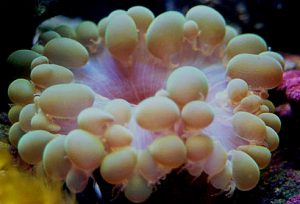
Figure 16. Hobbyists have reported that Bubble Corals (Plerogyra sinuosa) are broadcast spawners. Photo courtesy of Steve Ruddy.
Genus Solenosmilia
| Taxon | Sexuality | Reproduction |
|---|---|---|
| Solensomilia variabilis | Gonochoric | Broadcast (?) |
Family Faviidae
Genus Astreosmilia
Limited to the western Indian Ocean (Veron, 1986), few researchers have paid much attention to these corals, and no information on spawning habits is available.
Genus Australogyra
| Taxon | Sexuality | Reproduction |
|---|---|---|
| Australogyra zelli | Hermaphroditic | Broadcast |
Genus Barabattoia
| Taxon | Sexuality | Reproduction |
|---|---|---|
| Barabattoia amicorum | Hermaphroditic | Broadcast |
Genus Caulastrea (Candy Cane Corals)
| Taxon | Sexuality | Reproduction |
|---|---|---|
| Caulastrea furcata | Hermaphroditic | Broadcast |
Genus Cladocora (Tube Corals)
Cladocora specimens are often found on Florida live rock but their patchy spots or clusters of small polyps are not particularly spectacular. Some do not possess zooxanthellae making their small tentacles colorless. Their ‘tubes’ are ~1/8″ in diameter.
| Taxon | Sexuality | Reproduction |
|---|---|---|
| Cladocora caespitosa | Hermaphroditic | Broadcast |
Genus Colpophyllia(Grooved Brain Coral)
This genus is found only in the Atlantic (Veron, 1986).
| Taxon | Sexuality | Reproduction |
|---|---|---|
| Colpophyllia amaranthus | Broadcast | |
| Colpophyllia breviseralis | Broadcast | |
| Colpophyllia natans | Hermaphroditic | Broadcast |
Genus Cyphastrea
| Taxon | Sexuality | Reproduction |
|---|---|---|
| Cyphastrea chalcidicum | Hermaphroditic | Broadcast |
| Cyphastrea microphthalma | Hermaphroditic | Broadcast |
| Cyphastrea ocellina | Hermaphroditic | Brooder |
| Cyphastrea seraila | Hermaphroditic | Broadcast |
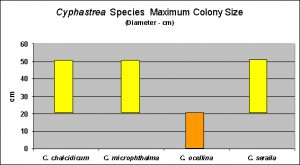
Figure 18. The brooder Cyphastrea ocellina has a smaller adult colony size than the Cyphastrea species that are broadcast spawners.
Maximum Colony Sizes of Various Cyphastrea Species
Information on maximum colony sizes of various Cyphastrea confirms once again that brooding corals are smaller in size than their broadcasting relatives. See Figure 18.
Genus Diploastrea
| Taxon | Sexuality | Reproduction |
|---|---|---|
| Diploastrea heliopora | Gonochoric | Broadcast |

Figure 19. Adventurer and reef hobbyist John Dawe watches a Diploria spawn at the Flower Garden Banks, Gulf of Mexico. Egg/sperm bundles are visible as white dots throughout the picture. Photo courtesy of Michael P. Janes.
Genus Diploria (Brain Corals)
This genus is found only in the Atlantic (Veron, 1986), and it is possible that specimens could hitchhike in on legally collected live rock.
| Taxon | Sexuality | Reproduction |
|---|---|---|
| Diploria clivosa | Hermaphroditic | Broadcast |
| Diploria labyrinthiformis | Hermaphroditic | Broadcast |
| Diploria labyrinthiformis | Hermaphroditic | Brooder |
| Diploria strigosa | Hermaphroditic | Broadcast |
| Diploria strigosa | Hermaphroditic | Brooder |
Sizes and Sexual Maturity of Diploria clivosa and D. strigosa
| Taxa | Puberty Size | Age | Reference |
|---|---|---|---|
| Diploria clivosa | >100 cm² | 7-9 years | Soong, 1992 |
| Diploria strigosa | >100 cm² | 7-9 years | Soong, 1992 |
Genus Echinopora
| Taxon | Sexuality | Reproduction |
|---|---|---|
| Echinopora gemmacea | Hermaphroditic | Broadcast |
| Echinopora horrida | Hermaphroditic | Broadcast |
| Echinopora lamellosa | Hermaphroditic | Broadcast |
| Echinopora pacificus | Hermaphroditic | Broadcast |
Genus Erythrastrea
This genus’ distribution is limited to the Red Sea (Veron, 1986) and no information on its reproductive habits is available.
Genus Favia (Star Corals)

Figure 22. A Favia specimen releases an egg or sperm bundle in the aquarium of master aquarist Tony Vargas. Photo courtesy of Tony Vargas. This Favia has been maintained in captivity since 2000, and is 8 inches in diameter. Spawning occurred in June 7, 2004 in the early morning, and the event lasted for ~1 hour. This coral had recently endured a move from New York to Florida.
Favia corals have been a mainstay in the reef aquarium hobby for many years. There are scattered reports of reproduction in aquaria.
| Taxon | Sexuality | Reproduction |
|---|---|---|
| Favia bennettae | Hermaphroditic | Broadcast |
| Favia doreyensis | Hermaphroditic | Broadcast |
| Favia favus | Hermaphroditic | Broadcast |
| Favia favus | Gonochoric | Broadcast |
| Favia favus | Hermaphroditic | Broadcast |
| Favia fragum | Hermaphroditic | Brooder |
| Favia helianthoides | Hermaphroditic | Broadcast |
| Favia laxa | Broadcast | |
| Favia lizardensis | Hermaphroditic | Broadcast |
| Favia matthai | Hermaphroditic | Broadcast |
| Favia pallida | Hermaphroditic | Broadcast |
| Favia rotumana | Broadcast | |
| Favia speciosa | Hermaphroditic | Broadcast |
| Favia stelligera | Hermaphroditic | Broadcast |
| Favia veroni | Hermaphroditic | Broadcast |

Figure 23. Favia fragum is known to reproduce in public aquaria. It is a brooder, matures at a small size (~ 50mm in diameter) and can be very attractive. Unfortunately, it is an Atlantic coral and is not readily available to hobbyists.
| Taxa | Puberty Size | Age | Reference |
|---|---|---|---|
| Favia doryensis | ? | 8 years | Connell, 1973 |
| Favia favus | ~3.5 cm² | 4 years | Oren et al., 2001 |
| Favia fragum | 2- 4 cm² | 1.5 – 2 years | Soong, 1992 |
Notes on Favia Puberty Size and Age
- Favia doryensis specimens are sexually mature at 8 years of age (Connell, 1974).
- Favia fragum has reproduced in aquaria. It is a small coral (no more than 2″ in diameter and broods its young).
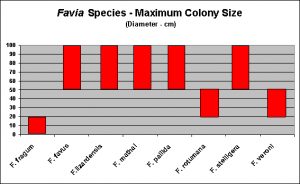
Figure 24. The trend continues… the brooding coral F. fragum is smaller than its broadcast spawning counterparts. Note that 100 cm diameter may not be the largest colony size, it is the largest category listed by the researcher (Soong, 1993).
Genus Favites
| Taxon | Sexuality | Reproduction |
|---|---|---|
| Favites abdita | Hermaphroditic | Broadcast |
| Favites bennettae | Hermaphroditic | Broadcast |
| Favites chinensis | Hermaphroditic | Broadcast |
| Favites complanata | Hermaphroditic | Broadcast |
| Favites flexuosa | Hermaphroditic | Broadcast |
| Favites halicora | Hermaphroditic | Broadcast |
| Favites pentagona | Hermaphroditic | Broadcast |
| Favites russelli | Hermaphroditic | Broadcast |
Genus Goniastrea (Honeycomb Coral)
| Taxon | Sexuality | Reproduction |
|---|---|---|
| Goniastrea aspera | Hermaphroditic | Broadcast |
| Goniastrea aspera | Hermaphroditic | Brooder |
| Goniastrea australensis | Hermaphroditic | Broadcast |
| Goniastrea edwardsi | Hermaphroditic | Broadcast |
| Goniastrea favulus | Hermaphroditic | Broadcast |
| Goniastrea favulus | Protandrous Hermaphrodite | |
| Goniastrea palauensis | Hermaphroditic | Broadcast |
| Goniastrea pectinata | Hermaphroditic | Broadcast |
| Goniastrea retiformis | Hermaphroditic | Broadcast |
Puberty Size and Age of Goniastrea Specimens
- Goniastrea aspera – less than 3″in diameter have only a slim chance of containing gonads, and proportion of mature colonies increases with colony size (Babcock, 1984)
- Goniastrea aspera and G. favulus reached reproductive age in about 5 years (Babcock, 1991).
Genus Leptastrea
| Taxon | Sexuality | Reproduction |
|---|---|---|
| Leptastrea bottae | Gonochoric | Broadcast |
| Leptastrea purpurea | Gonochoric | Broadcast |
Genus Leptoria
| Taxon | Sexuality | Reproduction |
|---|---|---|
| Leptoria phryia | Hermaphroditic | Broadcast |

Figure 25. The Caribbean Rose Coral (Manicina areolata) is now legally available for purchase by hobbyists. Photo courtesy Jake Adams and www.coralidea.com
Genus Manicina(Common Atlantic Rose Coral)
These beautiful Caribbean corals are being legally reared and are beginning to find there way to market in the U.S. Their small size and reproductive habits make them an idea candidate for captive propagation efforts. See this website for details on obtaining Manicina specimens: www.aquatouch.com
| Taxon | Sexuality | Reproduction |
|---|---|---|
| Manicina areolata | Hermaphroditic | Brooder |
Comment on M. areolata Adult Size
Adult Manicina specimens are ~3 inches long.
Genus Montastrea (Boulder Coral)
Montastrea corals are found in the Atlantic and Pacific Oceans.
| Taxon | Sexuality | Reproduction |
|---|---|---|
| Montastrea magnistellata | Hermaphroditic | Broadcast |
| Montastrea annularis | Hermaphroditic | Broadcast |
| Montastrea annuligera | Hermaphroditic | Broadcast |
| Montastrea cavernosa | Gonochoric | Broadcast |
| Montastrea curta | Hermaphroditic | Broadcast |
| Montastrea faveolata | Hermaphroditic | Broadcast |
| Montastrea franksi | Hermaphroditic | Broadcast |
| Montastrea valenciennesi | Hermaphroditic | Broadcast |
Age of Puberty for Montastrea annularis
Szmant (1986) estimates the age of puberty for Montastrea annularis is 5 to 6 years.
Genus Moseleya
| Taxon | Sexuality | Reproduction |
|---|---|---|
| Moseleya latistellata | Hermaphroditic | Brooder |
Genus Oulastrea (Zebra Coral)
| Taxon | Sexuality | Reproduction |
|---|---|---|
| Oulastrea crispa | Hermaphroditic | Broadcast |
| Oulastrea crispa | Hermaphroditic | Brooder |
Puberty Size of Oulastrea crispa
Colonies greater than 20mm in diameter are sexually mature (Lam, 2000).
Genus Oulophyllia
| Taxon | Sexuality | Reproduction |
|---|---|---|
| Oulophyllia bennettae | Hermaphroditic | Broadcast |
| Oulophyllia crispa | Hermaphroditic | Broadcast |
Genus Parasimplastrea
There is only one species (Parasimplastrea sheppardi). It has a very limited distribution, and no information is available on its reproductive habits.
Genus Platygyra
| Taxon | Sexuality | Reproduction |
|---|---|---|
| Platygyra contorta | Hermaphroditic | Broadcast |
| Platygyra daedalea | Hermaphroditic | Broadcast |
| Platygyra lamellina | Hermaphroditic | Broadcast |
| Platygyra pini | Hermaphroditic | Broadcast |
| Platygyra ryukuensis | Hermaphroditic | Broadcast |
| Platygyra sinensis | Hermaphroditic | Broadcast |
| Platygyra verweyi | Hermaphroditic | Broadcast |
Puberty Age of Platygyra sinensis
Platygyra sinensis reaches a reproductive state at ~5 years of age (Babcock, 1991).
Genus Plesiastrea
| Taxon | Sexuality | Reproduction |
|---|---|---|
| Plesiastrea verispora | Broadcast |
Genus Solenastrea
Solenastrea is an Atlantic species (Veron, 1986).
| Taxon | Sexuality | Reproduction |
|---|---|---|
| Solenastrea boumoni | Broadcast | |
| Solenastrea hyades | Broadcast |
Family Flabelliidae
Genus Flabellum
| Taxon | Sexuality | Reproduction |
|---|---|---|
| Flabellum alabastrum (deep water) | Gonochoric | |
| Flabellum angulare (deep water) | Gonochoric | |
| Flabellum curvatum (deep water) | Gonochoric | |
| Flabellum impensum (deep water) | Gonochoric | |
| Flabellum japonicum | Gonochoric | |
| Flabellum rubrum | Protandrous Hermaphrodite | |
| Flabellum rubrum | Hermaphroditic | |
| Flabellum thouarsii (deep water) | Gonochoric |
Notes on Flabellum rubrum Sexuality and Size
Flabellum rubrum – small colonies (13-20mm) are males; larger colonies are hermaphroditic (Gardiner, 1902, in Fadlallah, 1983).
Genus Gardineria
Azooxanthellate. No information on reproduction is available.
Genus Monomyces
No information on reproduction is available.
Genus Placotrochus
No information on reproduction is available.
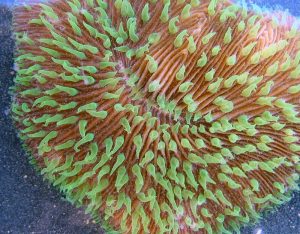
Figure 28. A female Fungia scutaria spawning at the Hawaii Institute of Marine Biology, Oahu, Hawaii. Note the tiny orange eggs being released. Photo courtesy of Jake Adams.
Family Fungiidae
As a rule, all Fungiids seen to be gonochoric with the exception of one report of Heliofungia actiniformis being a brooder.
Genus Cantharellus
This Fungiid has a wide geographical range, but is rarely seen. It sometimes lives attached to the substrate (Veron, 2000). No information is available on reproductive habits.
Genus Ctenactis
No information is available on reproductive habits.
Genus Cycloseris
YouTube has some interesting video clips showing a Cycloseris (tentative ID) broadcast spawning. It is tempting to state that Cycloseris, like other Fungiids, is a gonochoric broadcast spawner.
Genus Danafungia
No information is available on reproductive habits.
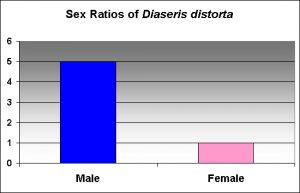
Figure 29. Sex ratios of Diaseris distorta in Galapagos Islands, Ecuador, where there are 5 males to every female colony.
Genus Diaseris
| Taxon | Sexuality | Reproduction |
|---|---|---|
| Diaseris distorta | Gonochoric | Broadcast |
Puberty Size and Sex Ratios of Diaseris distorta
Diaseris distorta (Colley et al., 2000) – Satellite colonies possess sex organs when colony size is ~1 cm2, while colonies produced sexually do not reach puberty until they are of larger size . Male colonies outnumber females by a ratio of 5 to 1 (in Ecuador).
Genus Fungia (Mushroom Coral)
| Taxon | Sexuality | Reproduction |
|---|---|---|
| Fungia actiniformis | See Heliofungia actiniformis | |
| Fungia concinna | Gonochoric | Broadcast |
| Fungia fungites | Gonochoric | Broadcast |
| Fungia granulosa | Gonochoric | Broadcast |
| Fungia horrida | Broadcast | |
| Fungia paumotensis | Gonochoric | Broadcast |
| Fungia repanda | Gonochoric | Broadcast |
| Fungia scutaria | Gonochoric | Broadcast |
| Fungia scutaria | Parthenogenic? | |
| Fungia sp. (Okinawa) | Gonochoric | Broadcast |
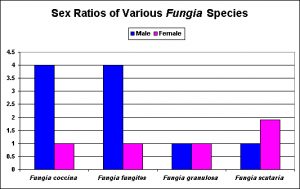
Figure 30. All Fungia species are gonochoric broadcast spawners. Sex ratios vary among species, and then even with environmental conditions. Based on information from Kramarsky-Winter and Loya (1998) and others.
Puberty Size, Age and Lifespan of Fungia Species
Fungia concinna and Fungia fungites are capable of reproduction at 4 years of age (equaling a size of ~6 cm in diameter; Harrison and Wallace, 1990). This information is in good agreement with that of Goffredo and Chadwick-Furman (2004) who report Fungia scutaria specimens are approximately 5 years of age when obtaining a diameter of 7 cm.
Further, these researchers report F. scutaria specimens are about 14 years old when they obtain a diameter of 22 cm. The estimated life span of F. scutaria is about 50 years.
| Taxa | Puberty Size | Age | Reference |
|---|---|---|---|
| Fungia coccinea | 6 cm diameter | 4 years | Harrison & Wallace, 1990 |
| Fungia fungites | 6 cm diameter | 4 years | Harrison & Wallace, 1990 |
| Fungia grandulosa | 5.5 cm diameter | ? | Kramarsky-Winter & Loya, 1998 |
| Fungia scutaria (male) | 2.5 – 6 cm diameter | ? | Kramarsky-Winter & Loya, 1998 |
| Fungia scutaria (female) | >9 cm diameter | ? | Kramarsky-Winter & Loya, 1998 |
| Heliofungia actiniformis | 8 cm diameter | 10 years | Connell, 1973 |
Genus Fungicyathus
This azooxanthellate coral can live at extreme depths – over 6,000 meters – the deepest of any coral (Veron, 2000). Needles to say, this coral is not likely to be found in your average reef aquarium!
| Taxon | Sexuality | Reproduction |
|---|---|---|
| Fungicyathus crispa | Gonochoric | |
| Fungicyathus fragilis | Gonochoric | |
| Fungicyathus marenzelleri | Gonochoric |
Genus Halomitra
No information available.
Genus Heliofungia (Plate Coral)
| Taxon | Sexuality | Reproduction |
|---|---|---|
| Heliofungia actiniformis | Hermaphroditic (?) | Brooder |
| Heliofungia actiniformis | Gonochoric | Broadcast |
Heliofungia Puberty Size and Age
Heliofungia actiniformis is reproductive at 10 years of age with a corresponding diameter of 8cm (Connell, 1973).
Genus Herpetoglossa
| Taxon | Sexuality | Reproduction |
|---|---|---|
| Herpetoglossa simplex | Gonochoric | Broadcast |
Genus Herpolitha
| Taxon | Sexuality | Reproduction |
|---|---|---|
| Herpolitha limax | Gonochoric | Broadcast |
Genus Lithophyllon
No information available.
Genus Podabacia
| Taxon | Sexuality | Reproduction |
|---|---|---|
| Podabacia crustacea | Gonochoric | Broadcast |
Genus Polyphyllia
| Taxon | Sexuality | Reproduction |
|---|---|---|
| Polyphyllia talpina | Gonochoric | Broadcast |
Genus Sandalolitha
| Taxon | Sexuality | Reproduction |
|---|---|---|
| Sandalolitha robusta | Gonochoric | Broadcast |
Genus Verilliofungia
No information available.
Genus Zoopilus
No information available.
Family Meandrinidae
This family has 4 genera found only in the Atlantic. For the purist, the Meandrinidae is sometimes spelled differently from the way it is listed in Veron’s Corals of the World (2000).
Genus Ctenella
No information available on the reproduction habits of the one known species (C. chagius) from the western Pacific. This coral has a limited distribution (Veron, 2000).
Genus Dendrogyra (Pillar Coral)
Only one known species (D. cylindrus), an uncommon coral from the Caribbean.
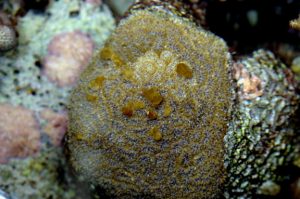
Figure 32. This Dendrogyra is reproducing asexually via ‘budding’ but it is also a gonochoric broadcast spawner. Photo courtesy of Julian Sprung.
| Taxon | Sexuality | Reproduction |
|---|---|---|
| Dendrogyra cylindrus | Gonochoric | Broadcast |
Genus Dichocoenia (Caribbean Starlet Coral)
Dichocoenia stokesi has been shown to spawn in September and October of each year (Hoke et al., 2002).
| Taxon | Sexuality | Reproduction |
|---|---|---|
| Dichocoenia stellaris | Brooder | |
| Dichocoenia stokesi | Gonochoric & Hermaphroditic | Broadcast |
Genus Eusmilia(Flower Coral)
A beautiful Caribbean coral which makes it a rarity in captivity.
| Taxon | Sexuality | Reproduction |
|---|---|---|
| Eusmilia fastigata | Broadcast |
Genus Gyrosmilia
Gyrosmilia has a relatively small geographical range and is found only in the West Indian Ocean & Red Sea. No information available on the one species known.
Genus Meandrina (Tan Brain Coral)
| Taxon | Sexuality | Reproduction |
|---|---|---|
| Meandrina areolata | ? | Brooder |
| Meandrina meandrites | Brooder |
Genus Montigyra
No information available on the one species known.
Family Merulinidae
Veron (1986) reports these corals are hermaphroditic broadcast spawners.
Genus Boninastrea
No specific information is available on reproductive habits.
Genus Hydnophora
| Taxon | Sexuality | Reproduction |
|---|---|---|
| Hydnophora exesa | Hermaphroditic | Broadcast |
| Hydnophora rigida | Hermaphroditic | Broadcast |
Genus Merulina
| Taxon | Sexuality | Reproduction |
|---|---|---|
| Merulina ampliata | Hermaphroditic | Broadcast |
| Merulina scabricula | Hermaphroditic | Broadcast |
Genus Paraclavarina
Paraclavarina specimens are occasionally seen in the trade. Although usually colored tan, their distinct shape makes them a worthwhile addition to a SPS tank. Table 61 uses the outdated name of Clavarina, per Babcock and Heyward’s 1986 description.
| Taxon | Sexuality | Reproduction |
|---|---|---|
| Clavarina triangularis | Hermaphroditic | Broadcast |
Genus Scapophyllia
| Taxon | Sexuality | Reproduction |
|---|---|---|
| Scapophyllia cylindrica | Hermaphroditic | Broadcast |
Family Micrabaciidae
Genus Stephanophyllia
| Taxon | Sexuality | Reproduction |
|---|---|---|
| Stephanophyllia formosissima | Brooder |
Family Mussidae
Genus Acanthastrea
Recent imports from Australia’s Great Barrier Reef have included a number of spectacular Acanthastrea specimens. Their fluorescent pigments are showcased in reef aquaria and, not surprisingly, are popular and command high prices – making them a good candidate for captive propagation efforts.
| Taxon | Sexuality | Reproduction |
|---|---|---|
| Acanthastrea hillae | Hermaphroditic | Broadcast |
| Acanthastrea echinata | Hermaphroditic | Broadcast |
| Acanthastrea lordhowensis | Hermaphroditic | Broadcast |
Genus Micromussa
Veron (2000) created this genus to distinguish corals containing certain skeletal details from those previously listed as Acanthastrea, and states that these corals are rare. His book lists 3 species. To my knowledge, there is spawning information on only one species.

Figure 34. The reproductive habits of Micromussa species have only recently been described. Photo courtesy Jake Adams and www.coralidea.com
| Taxon | Sexuality | Reproduction |
|---|---|---|
| Micromussa amakuensis | Broadcast |
Genus Mussismilia
| Taxon | Sexuality | Reproduction |
|---|---|---|
| Mussismilia braziliensis | Hermaphroditic | Broadcast |
| Mussismilia hartii | Hermaphroditic | Broadcast |
| Mussismilia hispida | Hermaphroditic | Broadcast |
| Mussismilia sp. | Hermaphroditic |
Genus Mussa(Flower Coral)
| Taxon | Sexuality | Reproduction |
|---|---|---|
| Mussa sp. | Hermaphroditic | |
| Mussa angulosa | Brooder |
Genus Isophyllia(Stalked Cactus Coral)
| Taxon | Sexuality | Reproduction |
|---|---|---|
| Isophyllia dipsacea | Gonochoric | Brooder (external) |
| Isophyllia sinuosa | Gonochoric | Brooder |
| Isophyllia sp. | Gonochoric (?) | Broadcast |
Isophyllia sinuosa Puberty/Adult Colony Size
Adult I. sinuosa specimens are about 6 inches in diameter.
Genus Isophyllastrea (Rough Star Coral)
Veron (2000) states this coral’s proper name as Isophyllia rigida, but I have listed it as the Coral Reef Task Force originally described it.
| Taxon | Sexuality | Reproduction |
|---|---|---|
| Isophyllastrea rigida | ? | Brooder |
Genus Mycetophyllia (Large Cactus Coral)
| Taxon | Sexuality | Reproduction |
|---|---|---|
| Mycetophyllia ailiciae | Hermaphroditic | Brooder |
| Mycetophyllia danaana | Brooder | |
| Mycetophyllia ferox | Hermaphroditic | Brooder |
| Mycetophyllia lamarckiana | Brooder | |
| Mycetophyllia reesi | Brooder |
Genus Australomussa
No information available.
Genus Blastomussa
No information available.
Genus Cynarina
| Taxon | Sexuality | Reproduction |
|---|---|---|
| Cynarina lacrymalis | Hermaphroditic | Broadcast |
Genus Lobophyllia
| Taxon | Sexuality | Reproduction |
|---|---|---|
| Lobophyllia corymbosa | Hermaphroditic | Broadcast |
| Lobophyllia hemprichii | Hermaphroditic | Broadcast |
| Lobophyllia pachysepta | Hermaphroditic | Broadcast |
| Lobophyllia sp. | Hermaphroditic |
Genus Scolymia (Fungus Coral)
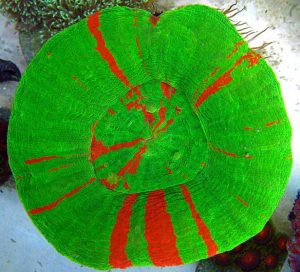
Figure 35. A strikingly beautiful Scolymia specimen. Photo courtesy Jake Adams and www.coralidea.com
| Taxon | Sexuality | Reproduction |
|---|---|---|
| Scolymia sp. (Atlantic) | ? | Brooder |
| Scolymia cubensis | See Scolymia wellsi | |
| Scolymia vitiensis | Hermaphroditic | Broadcast |
| Scolymia wellsi | Hermaphroditic | Brooder |
| Scolymia wellsi | Gonochoric (?) | Brooder |
Genus Symphyllia
| Taxon | Sexuality | Reproduction |
|---|---|---|
| Symphyllia radians | Hermaphroditic | Broadcast |
| Symphyllia recta | Hermaphroditic | Broadcast |
| Symphyllia sp. | Hermaphroditic |
Family Oculinidae
Genus Acrhelia
This genus was discontinued by Veron (2000), who considers Acrhelia horrescens to now be Galaxea horrescens. I include this information to avoid confusion.
It does not change the fact that Galaxea/Acrhelia horrescens is a brooder (Kawaguti, 1941).
| Taxon | Sexuality | Reproduction |
|---|---|---|
| Acrhelia horrescens | ? | Brooder |
Genus Galaxea (Galaxy Corals)
| Taxon | Sexuality | Reproduction |
|---|---|---|
| Galaxea aspera | ? | Brooder |
| Galaxea astreata | Hermaphroditic | Broadcast |
| Galaxea fascicularis | Hermaphroditic, female sterile | Broadcast |
| Galaxea fascicularis | Gonochoric | Broadcast |
| Galaxea horrescens | Brooder |
Genus Neohelia
| Taxon | Sexuality | Reproduction |
|---|---|---|
| Neohelia porcellana | Gonochoric (?) |
Genus Oculina (Bush Corals or Ivory Tree Coral)
| Taxon | Sexuality | Reproduction |
|---|---|---|
| Oculina sp. | Broadcast | |
| Oculina varicosa | Gonochoric | Broadcast |
| Oculina patagonica | Gonochoric | Broadcast |
Oculina varicosa spawns in late summer and early fall. Planula larvae settle at about 21 days of age (Brooke et al., 2002).
Genus Madepora
| Taxon | Sexuality | Reproduction |
|---|---|---|
| Madrepora oculata (deep water) | Gonochoric | ? |
Genus Schizoculina
No information available on reproductive habits.
Genus Simplastrea
No information available on reproductive habits.
Family Pectiniidae
All corals in Pectiniidae are hermaphroditic broadcast spawners (Veron, 1986).
Genus Echinomorpha
Contains one species, Echinomorpha (formerly Echinophyllia) nihihirai (Veron, 2000).
Genus Echinophyllia
Some Echinophyllia species are particularly colorful and command extreme prices. Unfortunately, observations of spawning within aquaria have not been made.
| Taxon | Sexuality | Reproduction |
|---|---|---|
| Echinophyllia aspera | Hermaphroditic | Broadcast |
| Echinophyllia orpheensis | Hermaphroditic | Broadcast |
Genus Mycedium
| Taxon | Sexuality | Reproduction |
|---|---|---|
| Mycedium elephantotus | Hermaphroditic | Broadcast |
Genus Oxypora
| Taxon | Sexuality | Reproduction |
|---|---|---|
| Oxypora glabra | Hermaphroditic | Broadcast |
| Oxypora lacera | Hermaphroditic | Broadcast |
Genus Pectinia
| Taxon | Sexuality | Reproduction |
|---|---|---|
| Pectinia alcicornis | Hermaphroditic | Broadcast |
| Pectinia lactuca | Hermaphroditic | Broadcast |
| Pectinia paeonia | Hermaphroditic | Broadcast |

Figure 37. Pocillopora eydouxi is a hermaphroditic broadcast spawner. Kauai, Hawaii. Photo by the author.
Family Pocilloporidae
Family Pocilloporidae contains 3 genera – Pocillopora, Seriatopora and Stylophora.
Genus Pocillopora (Wart Corals)

Figure 38. In this photo by David Kearnes, the normally clear waters off Kailua-Kona, Hawaii become cloudy with gametes during the seasonal Pocillopora meandrina spawnings.
| Taxon | Sexuality | Reproduction |
|---|---|---|
| Pocillopora bulbosa | See P. damicornis | Brooder |
| Pocillopora brevicornis | See P. damicornis | |
| Pocillopora caespitosa | See P. damicornis | Brooder |
| Pocillopora damicornis | Hermaphroditic | Brooder |
| Pocillopora damicornis | Parthenogenic? | |
| Pocillopora damicornis | Broadcast | |
| Pocillopora damicornis Type Y | Brooder | |
| Pocillopora damicornis Type B | Brooder | |
| Pocillopora elegans | ? | Brooder |
| Pocillopora eydouxi | Hermaphroditic | Broadcast |
| Pocillopora meandrina | Hermaphroditic | Broadcast |
| Pocillopora verrucosa | Hermaphroditic | Broadcast |
| Pocillopora verrucosa | ? | Broadcast |

Figure 39. Within hours, the water will swarm with billions of planula larvae. Only a few will survive long enough to settle. Photomicrograph by the author.
Puberty Sizes of Two Pocillopora Species
Pocillopora damicornis is probably the most researched species of any stony coral.
Jokiel (1997) states that Pocillopora damicornis at a size of 10 cm (~4″) diameter releases 220 planula larvae per month. Harrigan (1972) found P. damicornis as small as 5 cm in diameter can produce planulae (estimated to be 1-2 years old).
Ricmond (in Richmond and Hunter, 1990) states Pocillopora damicornis takes at least two years to mature. P. damicornis colonies in the eastern Pacific can live to at least 70 years of age (Richmond & Hunter, 1990).
During the 2008 Pocillopora meandrina mass spawning in Hawaii, the smallest colony observed spawning was ~6″ in diameter (personal observations), which is about 2″ less in diameter than the smallest mature colony observed by Stimson (1978).

Figure 40. Again, this figure demonstrates that a brooder (P. damicornis) is reproductive at a smaller size than the broadcast spawner (P. meandrina).
Genus Seriatopora (Bird’s Nest Corals)
| Taxon | Sexuality | Reproduction |
|---|---|---|
| Seriatopora caliendrum | Hermpahroditic | Brooder |
| Seriatopora hystrix | Hermaphroditic | Brooder |
Genus Stylophora (Club Coral)

Figure 41. The red morph of Seriatopora hystrix. It is a hermaphroditic brooder, making it a prime candidate for aquarium spawning, yet reports of reproduction in captivity are practically non-existent. Why? (This photo was taken during a recent visit to Salt Lake City. If this is your coral, please contact me and I’ll post a tardy photo credit).
| Taxon | Sexuality | Reproduction |
|---|---|---|
| Stylophora mordax | Brooder | |
| Stylophora pistillata | Hermaphroditic | Brooder |
| Stylophora pistillata | Protandrous Hermaphrodite |
Notes on Stylophora pistillata Sexuality
Stylophora pistillata is a male in its first year and then becomes hermaphroditic, capable of self-fertilization and brooding in its second year (Loya, 1976). Later, Rinkevich and Loya stated that Stylophora pistillata reaches puberty at 1.5 to 2 years of age.
Family Poritidae
Genus Alveopora
| Taxon | Sexuality | Reproduction |
|---|---|---|
| Alveopora daedalea | Hermaphroditic | Brooder |
| Alveopora japonica | Hermaphroditic | Brooder |
Genus Goniopora (Flower Pot Corals)
| Taxon | Sexuality | Reproduction |
|---|---|---|
| Goniopora columna | Gonochoric | Broadcast |
| Goniopora dijboutiensis | Gonochoric | Broadcast |
| Goniopora fruticosa | Possibly sterile | |
| Goniopora gigas | ? | Broadcast |
| Goniopora lobata | Gonochoric | Broadcast |
| Goniopora minor | Gonochoric | Broadcast |
| Goniopora norfolkensis | Gonochoric | Broadcast |
| Goniopora palauensis | Broadcast | |
| Goniopora queenslandiae | Gonochoric | Brooder |
| Goniopora savignyi | Gonochoric | Broadcast |
| Goniopora sp. | Gonochoric | Broadcast |
| Goniopora sp. 1 | Gonochoric | Broadcast |
| Goniopora tenuidens | Gonochoric | Broadcast |
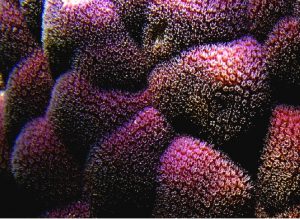
Figure 43. A Porites lutea, from a shallow tide pool in Keauhou, Hawaii. Photo by the author.
Genus Porites (Lobe and Finger Corals)
| Taxon | Sexuality | Reproduction |
|---|---|---|
| Porites andrewsi | Gonochoric | Broadcast |
| Porites annae | Broadcast | |
| Porites astreoides | Hermaphroditic | Brooder |
| Porites astreoides | Hermaphroditic & Female | Brooder |
| Porites astreoides | Hermaphrodite & Female/ Male | Brooder |
| Porites attenuata | Brooder | |
| Porites australensis | Gonochoric | Broadcast |
| Porites branneri | Brooder | |
| Porites brighami | Gonochoric or Hermaphroditic | Brooder |
| Porites clavaria | Gonochoric | Brooder |
| Porites colonensis | Brooder | |
| Porites compressa | Gonochoric | Broadcast |
| Porites cylindrica | Gonochoric | Broadcast |
| Porites divaricata | Brooder | |
| Porites evermanni | Gonochoric | Broadcast |
| Porites furcata | Gonochoric | Brooder |
| Porites haddoni | see Porites stephensoni | Brooder |
| Porites heronensis | Brooder | |
| Porites lichen | Hermaphroditic | Brooder |
| Porites lobata | Gonochoric | Broadcast |
| Porites lobata | Parthenogenic? | |
| Porites lutea | Gonochoric | Broadcast |
| Porites lutea | Parthenogenic? | |
| Porites murrayensis | Gonochoric | Brooder |
| Porites panamensis | Gonochoric | Brooder |
| Porites porites | Gonochoric | Brooder |
| Porites porites | Hermaphroditic | |
| Porites rus | Gonochoric | ? |
| Porites solida | Gonochoric | Broadcast |
| Porites stephensoni | ? | Brooder |
Notes on Porites Puberty Size and Sex Ratios
Porites andrewsi: 2:1 male/female, with a small percentage (~4%) being hermaphroditic.
Porites astreoides: A Caribbean coral, and within specimens containing gonads – some do not!) are found in percentages of 48% hermaphroditic to 52% female, giving a ratio, of course, ~1 to 1 (Chornesky and Peters, 1987). McGuire (1998) states that Porites astreoides capable of reproduction at 70 cm2 (approx. 14″ square).
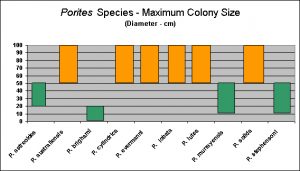
Figure 45. Brooders are in green, Broadcasters in orange. Note that adult size of brooders is always smaller that broadcasting species. Also note that 100 cm diameter may not be the largest possible colony size, it is the uppermost category listed by the researcher (Soong, 1993). For true maximum colony sizes of Porites lobata and P. lutea, see Figure 45. Note that P. brighami is endemic to Hawaii.
Porites lobata: Spawning ratios were 1:1 in Hawaii (Mate, 1997); ~1:1 at the Great Barrier Reef, Australia (Kojis and Quinn, 1981) and 1:1 in the eastern Pacific (but 14% of Costa Rican P. lobata colonies were hermaphroditic – Glynn et al., 1994).
Porites lutea: Roughly 1:1 at the Great Barrier Reef, Australia (Kojis and Quinn, 1981).
Harriot (1983) estimates Porites lutea reaches puberty at 4 years of age.
Porites murrayensis: Reproductive at 1.3 – 5.5 cm diameter (adult colonies are <20 cm in diameter) at Australia’s Great Barrier Reef (Kojis and Quinn, 1981).
Genus Poritipora
This genus, erected by Veron, 2000, has a limited distribution from the east coast of Africa and northeast to the Indian coast and nothing is known of its reproductive habits.
Genus Stylaraea
This genus contains but one species (S. punctata), and it is small (<15mm across). We could expect its reproductive size to be very small. It refers carbonate biofilms for settlement (Golbuu & Richmond, 2007). Information is available for S. punctata, but I lost the reference and am supremely disappointed that I cannot find that information in a stack of over 500 reference papers.
Subgenus Synaraea
Controversy about the validity of subgenus Synaraea exists (Veron 2000 lists Porites (Synaraea) rus as simply P. rus, but acknowledges the previous classification).
| Taxon | Sexuality | Reproduction |
|---|---|---|
| Porites rus | Gonochoric | ? |
Family Rhizangiidae
Genus Astrangia
| Taxon | Sexuality | Reproduction |
|---|---|---|
| Astrangia danae | Gonochoric | Broadcast |
| Astrangia lajollaensis | Gonochoric | Broadcast |
| Astrangia poculata | See A. danae |
Genus Culicia
No information available on this corals’ reproductive habits.
Family Siderastreidae
Many studies have been conducted on Siderastrea species from the Atlantic, some of which is listed here.
Genus Anomastraea
No information available on this corals’ reproductive habits.
Genus Coscinaraea
| Taxon | Sexuality | Reproduction |
|---|---|---|
| Coscinarea columna | Gonochoric | Broadcast |
Genus Horastrea
No information available on this coral’s reproductive habits.
Genus Psammocora
| Taxon | Sexuality | Reproduction |
|---|---|---|
| Psammocora contigua | Gonochoric | Broadcast |
| Psammocora digitata | Gonochoric | Broadcast |
| Psammocora stellata | ? | Brooder |

Figure 48. Siderastrea sizes – note that 100 cm diameter may not be the largest colony size, it is the largest category (50-100 cm) listed by the researcher (Soong, 1993).
Genus Pseudosiderastrea
No reproductive information available.
Genus Siderastrea (Starlet Corals)
Legally-collected Caribbean Siderastrea colonies (S. siderea, S. stellata or S. radians) may be available in the future (Michael Janes, personal communication). S. radians is relatively small, and generally considered to be a brooder, making it an excellent candidate for captive propagation efforts.
| Taxon | Sexuality | Reproduction |
|---|---|---|
| Siderastrea radians | Gonochoric | Brooder |
| Siderastrea radians | Hermaphroditic | Brooder |
| Siderastrea radians | Protandrous Hermaphrodite | |
| Siderastrea siderea | Brooder | |
| Siderastrea siderea | Gonochoric | Broadcast |
| Siderastrea stellata | Brooder |
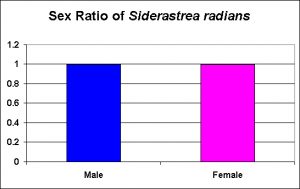
Figure 50. Males and females are found evenly in this case. It could be different in other areas due to any number of factors, but this has yet to be demonstrated for this coral species
Sex Ratios of Siderastrea radians
Siderastrea radians is found in male/female ratios of 1:1. (Lazar, internet resource, date unknown).
| Taxa | Puberty Size | Age | Reference |
|---|---|---|---|
| Siderastrea radians | 2- 4 cm² | 1.5 – 2 years | Soong, 1992 |
| Siderastrea siderea | >100 cm² | 7-9 years | Soong, 1992 |
Comments on Siderastrea Reproduction and Longevity
Siderastrea radians is a protogynous hermaphrodite (Duerden, 1902, in Fadlallah, 1983).

Figure 51. Siderastrea species have been carefully studied by a number of researchers, resulting in information such as this.
Elahi and Edmunds (2007) report that Siderastrea siderea colonies can be at least 125 years old (based on a growth rate of 4mm (~1/6″) per year). Siderastrea siderea juveniles are less than 40mm in diameter, and mature colonies are 5.9 – 11.4 cm in diameter.
Family Trachyphylliidae
Genus Trachyphyllia
There are limited reports of this coral broadcast spawning in aquaria (Tyree, 1994).
In Closing
As a matter of convenience (mostly mine), I have chosen to publish the reference list at the close of this series. If you like a copy earlier, please email me ([email protected]) and I’ll send this information in a Word document.
Next time, we’ll examine the reproduction habits of soft corals.
Acknowledgements
It would have been much easier to simply list the reproductive information of various stony corals. In fact, the initial draft of this article contained few photos. I felt this made the article a little too dry, so, I went, with hat in hand, to many sources asking for help – and thankfully a number of hobbyists and professional aquarists responded. Many thanks go to Dr. Bruce Carlson (once at the Waikiki Aquarium, but now at the Georgia Aquarium), Mitch (the King) Carl of the Henry Doorly Zoo, Omaha, Nebraska, Jake Adams (www.coralidea.com), Steve Ruddy (www.coralreefecosystems.com), Julian Sprung (www.twolittlefishies.com), master aquarist Tony Vargas, Michael P. Janes (www.aquatouch.com), and all the hobbyists across the country who extended a warm welcome to their homes and allowed me to take measurements
and photographs.
| Taxon | Sexuality | Reproduction | Vertical (egg) | Horizontal water 85% | Reference |
|---|---|---|---|---|---|
| Acanthastrea hillae | Hermaphroditic | Broadcast | Babcock et al., 1986 | ||
| Acanthastrea echinata | Hermaphroditic | Broadcast | Bermas et al., 1992 | ||
| Acanthastrea lordhowensis | Hermaphroditic | Broadcast | Wilson & Harrison, 1997 | ||
| Acrhelia horrescens | ? | Brooder | Kawaguti, 1941 | ||
| Acropora (Isopora) brueggemanni | Hermaphroditic | Brooder | Okubo et al., 2007 | ||
| Acropora (Isopora) cuneata | Hermaphroditic | Brooder | Bothwell, 1981 | ||
| Acropora (Isopora) palifera | Hermaphroditic | Brooder | Bothwell, 1981 | ||
| Acropora (Isopora) togianensis | Hermaphroditic | Brooder | Wallace et al., 2007 | ||
| Acropora aculeus | Hermaphroditic | Broadcast | Babcock et al., 1986 | ||
| Acropora acuminata | Broadcast | Rosser & Gilmour, in press | |||
| Acropora anthoceris | Hermaphroditic | Broadcast | see van Oppen | Babcock et al., 1986 | |
| Acropora aspera | Hermaphroditic | Broadcast | Bothwell, 1981 | ||
| Acropora austera | Hermaphroditic | Broadcast | Babcock et al., 1986 | ||
| Acropora caroliniana | Broadcast | Baird et al., 2000 | |||
| Acropora cerealis | Hermaphroditic | Broadcast | Babcock et al., 1986 | ||
| Acropora cervicornis | Hermaphroditic | Broadcast | Vargas-Ángel & Thomas, 2002 | ||
| Acropora clathrata | Hermaphroditic | Broadcast | Babcock et al., 1986 | ||
| Acropora corymbosa | Hermaphroditic | Brooder | Stimson, 1978 | ||
| Acropora cytheria | Hermaphroditic | Broadcast | Wallace et al., 2007 | ||
| Acropora danai | Hermaphroditic | Broadcast | Dai et al., 1992; Hayashibara et al.,1993 | ||
| Acropora delicatula | Possibly sterile | Richmond & Hunter, 1990 | |||
| Acropora delicatula | See Acropora selago | Broadcast | Wallace et al., 2007 | ||
| Acropora digitifera | Hermaphroditic | Broadcast | Wallace et al., 2007 | ||
| Acropora dilitata | Hermaphroditic | Broadcast | Heyward, 1985 | ||
| Acropora divaricata | Hermaphroditic | Broadcast | Babcock et al., 1986 | ||
| Acropora donei | Hermaphroditic | Broadcast | Guest et al., 2005; Hayashibara et al.,1993 | ||
| Acropora elseyi | Broadcast | Marquis et al., 2005 | |||
| Acropora eurystoma | Hermaphroditic | Broadcast | Shlesinger & Loya, 1985 | ||
| Acropora exquisita | Hermaphroditic | Broadcast | Hayashibara et al.,1993 | ||
| Acropora florida | Hermaphroditic | Broadcast | Babcock et al., 1986 | ||
| Acropora formosa | Hermaphroditic | Broadcast | Babcock et al., 1986 | ||
| Acropora gemmifera | Hermaphroditic | Broadcast | Morita et al., 2006 | ||
| Acropora glauca | ? | Broadcast | Babcock et al., 1986 | ||
| Acropora grandis | Hermaphroditic | Broadcast | Guest et al., 2002; Babcock et al., 1986 | ||
| Acropora grandulosa | Hermaphroditic | Broadcast | Wallace, 1985 | ||
| Acropora hemprichii | Hermaphroditic | Broadcast | Rinkevich and Loya, 1979 | ||
| Acropora horrida | Hermaphroditic | Broadcast | Wallace, 1985 | ||
| Acropora humilis | Hermaphroditic | Broadcast | Bothwell, 1981 | ||
| Acropora humilis | ? | Brooder | Stimson, 1978 | ||
| Acropora hyacinthus | Hermaphroditic | Broadcast | Wallace et al., 2007 | ||
| Acropora hystrix | Hermaphroditic | Broadcast | Heyward, 1989 | ||
| Acropora intermeda | Broadcast | X | Guest et al., 2005 | ||
| Acropora irregularis | Hermaphroditic | Broadcast | Heyward, 1989; Richmond & Hunter, 1990 | ||
| Acropora jacquelineae | Broadcast | Baird et al., 2000 | |||
| Acropora kimbeensis | Baird et al., 2000 | ||||
| Acropora “kosurini-like” | Broadcast | Rosser & Gilmour, in press | |||
| Acropora latistella | Hermaphroditic | Broadcast | Babcock et al., 1986 | ||
| Acropora lianae | Broadcast | Guest et al., 2005 | |||
| Acropora listeri | Broadcast | Harrison et al., 1984 | |||
| Acropora longicyathus | Hermaphroditic | Broadcast | Babcock et al., 1986 | ||
| Acropora loripes | Hermaphroditic | Broadcast | Babcock et al., 1986 | ||
| Acropora lutkeni | Hermaphroditic | Broadcast | Babcock et al., 1986 | ||
| Acropora microclados | Hermaphroditic | Broadcast | Guest et al., 2005; Hayashibara et al.,1993 | ||
| Acropora microphthalma | Hermaphroditic | Broadcast | Babcock et al., 1986 | ||
| Acropora millepora | Hermaphroditic | Broadcast | Babcock et al., 1986 | ||
| Acropora monticulosa | Hermaphroditic | Broadcast | Babcock et al., 1986 | ||
| Acropora muricata | Hermaphroditic | Broadcast | Wallace et al., 2007 | ||
| Acropora nana | Hermaphroditic | Broadcast | Dai et al., 1992 | ||
| Acropora nastua | Hermaphroditic | Broadcast | Babcock et al., 1986 | ||
| Acropora nobilis | Hermaphroditic | Broadcast | Babcock et al., 198 | ||
| Acropora ocellata | Hermaphroditic | Broadcast | Kenyan, 1992 | ||
| Acropora palawensis | ? | Brooder | Kawaguti, 1940 in Fadlallah, 1983 | ||
| Acropora palmata | Hermaphroditic | Broadcast | Miller et al., 2000 | ||
| Acropora palmerae | Broadcast | Dai et al., 1992 | |||
| Acropora papillare | Broadcast | Rosser & Gilmour, in press | |||
| Acropora plumosa | Broadcast | Baird et al., 2000 | |||
| Acropora polystoma | Broadcast | Rosser & Gilmour, in press | |||
| Acropora pulchra | Hermaphroditic | Broadcast | Babcock et al., 1986 | ||
| Acropora robusta | Hermaphroditic | Broadcast | Babcock et al., 1986 | ||
| Acropora samoensis | Hermaphroditic | Broadcast | Guest et al., 2005; Hayashibara et al.,1993 | ||
| Acropora sarmentosa | Hermaphroditic | Broadcast | Babcock et al., 1986 | ||
| Acropora scandens | Hermaphroditic | Broadcast | Babcock et al., 1986 | ||
| Acropora secale | Hermaphroditic | Broadcast | Babcock et al., 1986 | ||
| Acropora selago | Hermaphroditic | Broadcast | Babcock et al., 1986 | ||
| Acropora smithi | Hermaphroditic | Broadcast | Richmond & Hunter, 1990 | ||
| Acropora solitaryensis | Hermaphroditic | Broadcast | Harrison, 2008 | ||
| Acropora spathulata | Broadcast | Baird et al., 2000 | |||
| Acropora spicifera | Broadcast | Dai et al., 1992 | |||
| Acropora squarrosa | Hermaphroditic | Broadcast | Kenyon, 1992 | ||
| Acropora striata | ? | Brooder | Stimson, 1978 | ||
| Acropora subulata | Broadcast | Rosser & Gimour, in press | |||
| Acropora surculosa | Hermaphroditic | Broadcast | Kenyon, 1992 | ||
| Acropora tenuis | Hermaphroditic | Broadcast | Babcock et al., 1986 | ||
| Acropora tortuosa | Hermaphroditic | Broadcast | Harrison, 2008 | ||
| Acropora valenciennesi | Hermaphroditic | Broadcast | Hayashibara et al.,1993 | ||
| Acropora valida | Hermaphroditic | Broadcast | Babcock et al., 1986 | ||
| Acropora variabilis | Hermaproditic | Broadcast | Shlesinger et al., 1998 | ||
| Acropora vaughani | Broadcast | Rosser & Gimour, in press | |||
| Acropora verweyi | Hermaphroditic | Broadcast | Guest et al., 2005; Hayashibara et al.,1993 | ||
| Acropora willisae | Broadcast | Negri et al., 2001 | |||
| Acropora yongei | Hermaphroditic | Broadcast | Babcock et al., 1986 | ||
| Agaricia agaricites | Hermaphroditic | Brooder | Gleason et al., 2001 | ||
| Agaricia crassa | ? | Brooder | Vaughan, 1908; in Fadlallah, 1983 | ||
| Agaricia fragilis | ? | Brooder | Mayor, 1915; in Fadlallah, 1983 | ||
| Agaricia grahame | ? | Brooder | NOAA Data base | ||
| Agaricia humilis | Hermaphroditic | Brooder | van Moorsel, 1980 | ||
| Agaricia lamarcki | ? | Brooder | NOAA Data base | ||
| Agaricia purpurea | Hermaphroditic | Brooder | van Moorsel, 1980 | ||
| Agaricia tenufolia | ? | Brooder | NOAA Data base | ||
| Agaricia undata | ? | Brooder | NOAA Data base | ||
| Alveopora daedalea | Hermaphroditic | Brooder | Shlesinger et al., 1998 | ||
| Alveopora japonica | Hermaphroditic | Brooder | Igarashi et al., 1992 | ||
| Anacropora matthai | Broadcast | Wallace et al., 2007 | |||
| Astrangia danae | Gonochoric | Broadcast | Szmant-Froelich et al., 1980 | ||
| Astrangia lajollaensis | Gonochoric | Broadcast | Fadlallah, 1982 | ||
| Astrangia poculata | See A. danae | Fitzgerlad & Szmant, 1997 | |||
| Astreopora gracilis | Broadcast | Dai et al., 1992 | |||
| Astreopora listeri | Broadcast | Dai et al., 1992 | |||
| Astreopora myriophthalma | Hermaproditic | Broadcast | Shlesinger et al., 1998 | ||
| Astreopora randalli | Hermaproditic | Broadcast | Richmond & Hunter, 1990 | ||
| Australogyra zelli | Hermaphroditic | Broadcast | Babcock et al., 1986 | ||
| Balanophyllia elegans | Gonochoric | Brooder | Fadlallah & Pearse, 1982 | ||
| Balanophyllia europaea | Hermaphroditic | Brooder | Goffredo et al., 2005 | ||
| Balanophyllia pruvoti | Gonochoric | Radetic et al., 2002 | |||
| Balanophyllia regia | Gonochoric (?) | Brooder | Goffredo et al., 2005 | ||
| Balanophyllia sp. | Brooder | Abe, 1937, in Fadlallah, 1983 | |||
| Barabattoia amicorum | Hermaphroditic | Broadcast | Babcock et al., 1986 | ||
| Catalaphyllia jarderni | Gonochoric | Broadcast | Willis et al., 1995 | ||
| Caulastrea furcata | Hermaphroditic | Broadcast | Babcock et al., 1986 | ||
| Cladocora caespitosa | Hermaphroditic | Broadcast | Kružić et al., 2008 | ||
| Cladopsammia rolandi | Hermaphroditic | Brooder | de Lacaze-Duthiers, 1897, in Fadlallah, 1983 | ||
| Clavarina triangularis | Hermaphroditic | Broadcast | Babcock & Heyward, 1986; Babcock et al., 1986 | ||
| Colpophyllia amaranthus | Broadcast | NOAA Database | |||
| Colpophyllia breviseralis | Broadcast | NOAA Database | |||
| Colpophyllia natans | Hermaphroditic | Broadcast | NOAA Database | ||
| Coscinarea columna | Gonochoric | Broadcast | Babcock et al., 1986 | ||
| Cynarina lacrymalis | Hermaphroditic | Broadcast | Shlesinger et al., 1998 | ||
| Cyphastrea chalcidicum | Hermaphroditic | Broadcast | Dai et al., 1992; Babcock et al., 1986 | ||
| Cyphastrea microphthalma | Hermaphroditic | Broadcast | Shlesinger et al., 1998 | ||
| Cyphastrea ocellina | Hermaphroditic | Brooder | Stimson, 1978; Kolinski & Cox, 2003 | ||
| Cyphastrea seraila | Hermaphroditic | Broadcast | Wilson, 1997; Hayashibara et al.,1993 | ||
| Dendrogyra cylindrus | Gonochoric | Broadcast | Szmant, 1986 | ||
| Dendrophyllia nigrescens | See Tubastraea spp. | ||||
| Dendrophyllia sp. | Gonochoric | Brooder | Babcock et al., 1986 | ||
| Diaseris distorta | Gonochoric | Broadcast | Colley et al., 2000 | ||
| Dichocoenia stellaris | Brooder | NOAA Data base | |||
| Dichocoenia stokesi | Gonochoric & Hermaphroditic | Broadcast | Hoke et al., 2002 | ||
| Diploastrea heliopora | Gonochoric | Broadcast | Hayashibara et al.,1993 | ||
| Diploria clivosa | Hermaphroditic | Broadcast | Alvarado et al., 2003; NOAA Data base | ||
| Diploria labyrinthiformis | Hermaphroditic | Broadcast | Alvarado et al., 2003 | ||
| Diploria labyrinthiformis | Hermaphroditic | Brooder | Duerden, 1902 in Fadlallah, 1983 | ||
| Diploria strigosa | Hermaphroditic | Broadcast | Alvarado et al., 2003 | ||
| Diploria strigosa | Hermaphroditic | Brooder | Hagman et al., 1998 | ||
| Echinophyllia aspera | Hermaphroditic | Broadcast | Dai et al., 1992; Fan & Dai, 1992 | ||
| Echinophyllia orpheensis | Hermaphroditic | Broadcast | Babcock et al., 1986 | ||
| Echinopora gemmacea | Hermaphroditic | Broadcast | Babcock & Heyward, 1986 | ||
| Echinopora horrida | Hermaphroditic | Broadcast | Babcock et al., 1986 | ||
| Echinopora lamellosa | Hermaphroditic | Broadcast | Babcock et al., 1986 | ||
| Echinopora pacificus | Hermaphroditic | Broadcast | Hayashibara et al.,1993 | ||
| Enallopsammia rostrata( deep water) | Gonochoric | Waller, 2005 | |||
| Euphyllia ancora | Gonochoric | Broadcast | Willis et al., 1985 | ||
| Euphyllia divisa | Gonochoric | Broadcast | Babcock et al., 1986 | ||
| Euphyllia glabrescens | Hermaphroditic | Brooder | Huang et al., 2008 | ||
| Euphyllia parancora | Gonochoric? | Broadcast | ASIRA Data base | ||
| Euphyllia rugosa | Brooder | ASIRA Data base | |||
| Eusmilia fastigata | Broadcast | Coral Reef Task Force Data base | |||
| Favia bennettae | Hermaphroditic | Broadcast | Babcock et al., 1986 | ||
| Favia doreyensis | Hermaphroditic | Broadcast | Marshall & Stephenson, 1933, in Fadlallah, 1983 | ||
| Favia favus | Hermaphroditic | Broadcast | Shlesinger et al., 1998 | ||
| Favia favus | Gonochoric | Broadcast | Alvarado et al., 2003 | ||
| Favia favus | Hermaphroditic | Broadcast | Hayashibara et al.,1993 | ||
| Favia fragum | Hermaphroditic | Brooder | Alvarado et al., 2003 | ||
| Favia helianthoides | Hermaphroditic | Broadcast | Bermas et al., 1992 | ||
| Favia laxa | Broadcast | Dai et al., 1992 | |||
| Favia lizardensis | Hermaphroditic | Broadcast | Babcock et al., 1986 | ||
| Favia matthai | Hermaphroditic | Broadcast | Babcock et al., 1986 | ||
| Favia pallida | Hermaphroditic | Broadcast | Penland et al., 2004; Babcock & Hey ward,1986 | ||
| Favia rotumana | Broadcast | Harrison et al., 1984 | |||
| Favia speciosa | Hermaphroditic | Broadcast | Penland et al., 2004; Dai et al, 1992 | ||
| Favia stelligera | Hermaphroditic | Broadcast | Babcock et al., 1986 | ||
| Favia veroni | Hermaphroditic | Broadcast | Babcock et al., 1986 | ||
| Favites abdita | Hermaphroditic | Broadcast | Penland et al., 2004; Wallace et al., 2007 | ||
| Favites bennettae | Hermaphroditic | Broadcast | Babcock et al., 1986 | ||
| Favites chinensis | Hermaphroditic | Broadcast | Nowzawa & Harrison, 2005 | ||
| Favites complanata | Hermaphroditic | Broadcast | Babcock & Heyward, 1986 | ||
| Favites flexuosa | Hermaphroditic | Broadcast | Babcock et al., 1986 | ||
| Favites halicora | Hermaphroditic | Broadcast | Penland et al., 2004; Babcock et al., 1986 | ||
| Favites pentagona | Hermaphroditic | Broadcast | Oliver and Babcock, 1992 | ||
| Favites russelli | Hermaphroditic | Broadcast | Dai et al., 1992; Babcock et al., 1986 | ||
| Flabellum alabastrum (deep water) | Gonochoric | Fadlallah, 1983 | |||
| Flabellum angulare (deep water) | Gonochoric | Waller, 2005 | |||
| Flabellum curvatum (deep water) | Gonochoric | Waller, 2005 | |||
| Flabellum impensum (deep water) | Gonochoric | Waller, 2005 | |||
| Flabellum japonicum | Gonochoric | Fadlallah, 1983 | |||
| Flabellum rubrum | Protandrous Hermaphrodite | Moseley, 1881, in Fadlallah, 1983 | |||
| Flabellum rubrum | Hermaphroditic | Fadlallah, 1983 | |||
| Flabellum thouarsii (deep water) | Gonochoric | Waller, 2005 | |||
| Fungia actiniformis | See Heliofungia actiniformis | ||||
| Fungia concinna | Gonochoric | Broadcast | X | Oliver, 1985 | |
| Fungia fungites | Gonochoric | Broadcast | Penland et al., 2004; Babcock et al., 1986 | ||
| Fungia granulosa | Gonochoric | Broadcast | Kramarsky-Winter & Loya, 1998 | ||
| Fungia horrida | Broadcast | Babcock et al., 2003 | |||
| Fungia paumotensis | Gonochoric | Broadcast | Willis et al., 1985 | ||
| Fungia repanda | Gonochoric | Broadcast | Hayashibara et al.,1993 | ||
| Fungia scutaria | Gonochoric | Broadcast | Kolinski & Cox, 2003 | ||
| Fungia scutaria | Parthenogenic? | Krupp, 1983 | |||
| Fungia sp. (Okinawa) | Gonochoric | Broadcast | Heyward et al., 1987 | ||
| Fungicyathus crispa | Gonochoric | Waller, 2005 | |||
| Fungicyathus fragilis | Gonochoric | Waller, 2005 | |||
| Fungiacyathus marenzelleri | Gonochoric | Waller, 2005 | |||
| Galaxea aspera | ? | Brooder | Fadlallah, 1983 | ||
| Galaxea astreata | Hermaphroditic | Broadcast | Dai et al., 1992; Babcock et al., 1986 | ||
| Galaxea fascicularis | Hermaphroditic, female sterile | Broadcast | Shlesinger et al., 1998; Hayakawa et al., 2005 | ||
| Galaxea fascicularis | Gonochoric | Broadcast | Harrison & Wallace, 1990; Hayakawa et al., 2005 | ||
| Galaxea horrescens | Brooder | ASIRA Data base | |||
| Gardineroseris planulata | Hermaphroditic | Glynn et al., 1996 | |||
| Goniastrea aspera | Hermaphroditic | Broadcast | Penland et al., 2004 | ||
| Goniastrea aspera | Hermaphroditic | Brooder | Nishikawa & Sakai, 2003 | ||
| Goniastrea australensis | Hermaphroditic | Broadcast | Penland et al., 2004; Wilson & Harrison, 2005 | ||
| Goniastrea edwardsi | Hermaphroditic | Broadcast | Penland et al., 2004 | ||
| Goniastrea favulus | Hermaphroditic | Broadcast | X | Alvarado et al., 2003 | |
| Goniastrea favulus | Protandrous Hermaphrodite | Kojis & Quinn, 1981 | |||
| Goniastrea palauensis | Hermaphroditic | Broadcast | Penland et al., 2004 | ||
| Goniastrea pectinata | Hermaphroditic | Broadcast | Penland et al., 2004 | ||
| Goniastrea retiformis | Hermaphroditic | Broadcast | Shlesinger et al., 1998 | ||
| Goniocorella dumosa (deep water) | Gonochoric | Waller, 2005 | |||
| Goniopora columna | Gonochoric | Broadcast | Willis et al., 1985 | ||
| Goniopora dijboutiensis | Gonochoric | Broadcast | Willis et al., 1985 | ||
| Goniopora fruticosa | Possibly sterile | Richmond & Hunter, 1990 | |||
| Goniopora gigas | ? | Broadcast | Petersen et al., 2007 | ||
| Goniopora lobata | Gonochoric | Broadcast | Babcock & Heyward, 1986; Babcock et al., 1986 | ||
| Goniopora minor | Gonochoric | Broadcast | Babcock et al., 1986 | ||
| Goniopora norfolkensis | Gonochoric | Broadcast | Babcock et al., 1986 | ||
| Goniopora palauensis | Broadcast | Babcock et al., 1986 | |||
| Goniopora queenslandiae | Gonochoric | Brooder | Yamazato et al., 1975, in Fadlallah, 1983 | ||
| Goniopora savignyi | Gonochoric | Broadcast | Shlesinger et al., 1998 | ||
| Goniopora sp. | Gonochoric | Broadcast | Babcock et al., 1986 | ||
| Goniopora sp. 1 | Gonochoric | Broadcast | Babcock et al., 1986 | ||
| Goniopora tenuidens | Gonochoric | Broadcast | Willis et al., 1985 | ||
| Heliofungia actiniformis | Hermaphroditic (?) | Brooder | Abe, 1937 in Krupp, 1983; Fadlallah, 1983 | ||
| Heliofungia actiniformis | Gonochoric | Broadcast | Willis et al., 1985; Babcock et al., 1986 | ||
| Helioseris cucullata | Brooder | NOAA Data base | |||
| Herpetoglossa simplex | Gonochoric | Broadcast | Babcock et al., 1986 | ||
| Herpolitha limax | Gonochoric | Broadcast | Babcock et al., 1986 | ||
| Heteropsammia aequicostatus | Gonochoric | Broadcast | Fisk, 1981 | ||
| Heteropsammia cochlea | Gonochoric | Broadcast | Fisk, 1981 | ||
| Hydnophora exesa | Hermaphroditic | Broadcast | Babcock et al., 1986 | ||
| Hydnophora rigida | Hermaphroditic | Broadcast | Babcock et al., 1986 | ||
| Isophyllastrea rigida | ? | Brooder | Coral Reef Task Force data | ||
| Isophyllia dipsacea | Gonochoric | Brooder (external) | Fadlallah, 1985 | ||
| Isophyllia sinuosa | Gonochoric | Brooder | Fadlallah, 1983 | ||
| Isophyllia sp. | Gonochoric (?) | Broadcast | Babcock et al., 1986 | ||
| Isopora brueggemanni | Hermaphroditic | Brooder | Okubo et al., 2007 | ||
| Isopora togianensis | Hermaphroditic | Brooder | Wallace et al., 2007 | ||
| Leptastrea bottae | Gonochoric | Broadcast | Kolinski & Cox, 2003 | ||
| Leptastrea purpurea | Gonochoric | Broadcast | Kolinski & Cox, 2003 | ||
| Leptopsammia pruvoti | Gonochoric | Brooder | X | Kružić et al., 2008 | |
| Leptoria phryia | Hermaphroditic | Broadcast | Dai et al., 1992; Babcock et al., 1986 | ||
| Lobophyllia corymbosa | Hermaphroditic | Broadcast | Harriot, 1983 | ||
| Lobophyllia hemprichii | Hermaphroditic | Broadcast | Willis et al., 1985 | ||
| Lobophyllia pachysepta | Hermaphroditic | Broadcast | Marquis et al., 2005; Babcock et al., 1986 | ||
| Lobophyllia sp. | Hermaphroditic | Marshall & Stephenson, 1933; in Fadlallah, 1983 | |||
| Lophelia pertusa (deep water) | Gonochoric | ? | Waller, 2005; Waller & Tyler, 2005 | ||
| Madracis carmabi | Hermaphroditc | Brooder | Vermeij et al., 2004 | ||
| Madracis decactis | Hermaphroditc | Brooder | Vermeij et al., 2004 | ||
| Madracis formosa | Hermaphroditc | Brooder | Vermeij et al., 2004 | ||
| Madracis mirabilis | Hermaphroditc | Brooder | Vermeij et al., 2004 | ||
| Madracis pharensis | Hermaphroditc | Brooder | X | Vermeij et al., 2004 | |
| Madracis senaria | Hermaphroditc | Brooder | X | Vermeij et al., 2004 | |
| Madrepora oculata (deep water) | Gonochoric | ? | Waller & Tyler, 2005 | ||
| Manicina areolata | Hermaphroditic | Brooder | Fadlallah, 1983 | ||
| Meandrina areolata | ? | Brooder | Yonge, 1935, in Fadlallah, 1983 | ||
| Meandrina meandrites | Brooder | NOAA Data base | |||
| Merulina ampliata | Hermaphroditic | Broadcast | Penland et al., 2004; Babcock et al., 1986 | ||
| Merulina scabricula | Hermaphroditic | Broadcast | Hayashibara et al.,1993 | ||
| Micromussa amakuensis | Broadcast | Mezaki et al., 2007 | |||
| Montastrea magnistellata | Hermaphroditic | Broadcast | Babcock et al., 1986 | ||
| Montastrea annularis | Hermaphroditic | Broadcast | Alvarado et al., 2003 | ||
| Montastrea annuligera | Hermaphroditic | Broadcast | Babcock et al., 1986 | ||
| Montastrea cavernosa | Gonochoric | Broadcast | Alvarado et al., 2003 | ||
| Montastrea curta | Hermaphroditic | Broadcast | Wilson, 1997; Babcock et al., 1986 | ||
| Montastrea faveolata | Hermaphroditic | Broadcast | X | Levitan et al., 2004; Steiner, 1995 | |
| Montastrea franksi | Hermaphroditic | Broadcast | Levitan et al., 2004; Szmant et al., 1997 | ||
| Montastrea valenciennesi | Hermaphroditic | Broadcast | Dai et al., 1992; Babcock et al., 1986 | ||
| Montipora aequituberculata | Hermaphroditic | Broadcast | Dai et al., 1992 | ||
| Montipora altasepta | Hermaphroditic | Broadcast | X | Penland et al., 2004 | |
| Montipora cactus | Hermaproditic | Broadcast | Penland et al., 2004; Wallace et al., 2007 | ||
| Montipora capitata | Hermaproditic | Broadcast | Heyward, 1986 | ||
| Montipora crassituberculata | Hermaproditic | Penland et al., 2004 | |||
| Montipora digitata | Hermaproditic | Broadcast | Penland et al., 2004; Morita et al., 2006 | ||
| Montipora dilatata | Hermaproditic | Broadcast | Heyward, 1986 | ||
| Montipora efflorescens | Hermaphroditic | Broadcast | Wallace et al., 2007 | ||
| Montipora effusa | Broadcast | Yeemin, 1988 | |||
| Montipora erythraea | Hermaproditic | Broadcast | Shlesinger et al., 1998 | ||
| Montipora eydouxi | Hermaphroditic | Broadcast | Hirose et al., 2000 | ||
| Montipora faveolata | Hermaphroditic | Broadcast | Richmond & Hunter, 1990 | ||
| Montipora flabellata | Hermaphroditic | Broadcast | Heyward, 1986 | ||
| Montipora floweri | Hermaphroditic | Broadcast | Hayashibara et al.,1993 | ||
| Montipora foliosa | Hermaphroditic | Broadcast | n/a | n/a | Dai et al., 1992 |
| Montipora hispida | Hermaproditic | Broadcast | Penland et al., 2004; Babcock et al., 1986 | ||
| Montipora informis | Hermaphroditic | Broadcast | Dai et al., 1992 | ||
| Montipora monasteriata | Hermaphroditic | Broadcast | Babcock et al., 1986 | ||
| Montipora patula | Hermaphroditic | Broadcast | Heyward, 1986 | ||
| Montipora peltiformis | Broadcast | Mundy & Babcock, 1998 | |||
| Montipora ramosa | Broadcast | Harrison et al., 1984 | |||
| Montipora samarensis | Hermaphroditic | Penland et al., 2004 | |||
| Montipora spumosa | Hermaphroditic | Broadcast | Babcock et al., 1986 | ||
| Montipora studeri | Hermaphroditic | Broadcast | Heyward, 1986 | ||
| Montipora tuberculosa | Broadcast | Babcock & Heyward, 1986 | |||
| Montipora turgescens | Hermaphroditic | Broadcast | Babcock et al., 1986 | ||
| Montipora turtlenesis | Hermaphroditic | Broadcast | Babcock et al., 1987 | ||
| Montipora venosa | Hermaphroditic | Broadcast | Dai et al., 1992; Hayashibara et al.,1993 | ||
| Montipora verrilli | Hermaphroditic | Broadcast | Heyward, 1986 | ||
| Montipora verrucosa | Hermaphroditic | Broadcast | Maté et al., 1998 | ||
| Moseleya latistellata | Hermaphroditic | Brooder | Wallace et al., 2007 | ||
| Mussa sp. | Hermaphroditic | Steiner, 1993 | |||
| Mussa angulosa | Brooder | Coral Reef Task Force data | |||
| Mussismilia braziliensis | Hermaphroditic | Broadcast | Pires et al., 1999 | ||
| Mussismilia hartii | Hermaphroditic | Broadcast | Pires et al., 2002 | ||
| Mussismilia hispida | Hermaphroditic | Broadcast | Pires et al., 2002 | ||
| Mussismilia sp. | Hermaphroditic | Pires et al., 1999 | |||
| Mycedium elephantotus | Hermaphroditic | Broadcast | Babcock & Heyward, 1986 | ||
| Mycetophyllia ailiciae | Hermaphroditic | Brooder | Szmant, 1986 | ||
| Mycetophyllia danaana | Brooder | Coral Reef Task Force data | |||
| Mycetophyllia ferox | Hermaphroditic | Brooder | Szmant, 1986 | ||
| Mycetophyllia lamarckiana | Brooder | Coral Reef Task Force data | |||
| Mycetophyllia reesi | Brooder | X | Coral Reef Task Force data | ||
| Oulastrea crispa | Hermaphroditic | Broadcast | Lam, 2000 | ||
| Oulastrea crispa | Hermaphroditic | Brooder | Lam, 2000 | ||
| Neohelia porcellana | Gonochoric (?) | Pratt, 1900, in Fadlallah, 1983 | |||
| Oculina sp. | Broadcast | Brooke & Young, 2003 | |||
| Oculina varicosa | Gonochoric | Broadcast | Brooke & Young, 2003 | ||
| Oculina patagonica | Gonochoric | Broadcast | Fine et al., 2001 | ||
| Oulophyllia bennettae | Hermaphroditic | Broadcast | Bermas et al., 1992 | ||
| Oulophyllia crispa | Hermaphroditic | Broadcast | Babcock et al., 1986 | ||
| Oxypora glabra | Hermaphroditic | Broadcast | Babcock et al., 1986 | ||
| Oxypora lacera | Hermaphroditic | Broadcast | Mundy & Babcock, 1998; Babcock et al., 1986 | ||
| Pachyseris rugosa | Gonochoric | Broadcast | Dai et al., 1992; Babcock et al., 1986 | ||
| Pachyseris speciosa | Gonochoric | Broadcast | Penland et al., 2004; Baird et al., 2001 | ||
| Pavona cactus | Gonochoric | ? | Marshall & Stephenson, 1933; in Fadlallah, 1983 | ||
| Pavona duerdeni | Gonochoric | Broadcast | Kolinski & Cox, 2003 | ||
| Pavona explanata | Gonochoric (?) | Stimson, 1978 | |||
| Pavona gigantea | Gonochoric | Broadcast | Glynn et al., 1996 | ||
| Pavona varians | Gonochoric | Broadcast | Maté, 1998; Shlesinger et al., 1998 | ||
| Pectinia alcicornis | Hermaphroditic | Broadcast | Penland et al., 2004; Babcock & Hey ward,1986 | ||
| Pectinia lactuca | Hermaphroditic | Broadcast | Bermas et al., 1992 | ||
| Pectinia paeonia | Hermaphroditic | Broadcast | Babcock & Heyward, 1986 | ||
| Physogyra lichtensteini | Gonochoric | Broadcast | Babcock et al., 1986 & 2003 | ||
| Platygyra contorta | Hermaphroditic | Broadcast | Hayashibara et al.,1993 | ||
| Platygyra daedalea | Hermaphroditic | Broadcast | Mangubhai & Harrison, 2008 | ||
| Platygyra lamellina | Hermaphroditic | Broadcast | Shlesinger et al., 1998; Dai et al., 1992 | ||
| Platygyra pini | Hermaphroditic | Broadcast | Mangubhai & Harrison, 2008 | ||
| Platygyra ryukuensis | Hermaphroditic | Broadcast | Heyward, 1988 | ||
| Platygyra sinensis | Hermaphroditic | Broadcast | Wallace et al., 2007; Oliver and Babcock, 1992 | ||
| Platygyra verweyi | Hermaphroditic | Broadcast | Mangubhai & Harrison, 2008 | ||
| Plerogyra sinuosa | Broadcast | ASIRA Data base | |||
| Plesiastrea verispora | Broadcast | Dai et al., 1992 | |||
| Pocillopora bulbosa | See P. damicornis | Brooder | Goffredo et al., 2006 | ||
| Pocillpora brevicornis | See P. damicornis | ||||
| Pocillopora caespitosa | See P. damicornis | Brooder | X | Benayahu et al., 1992 | |
| Pocillopora damicornis | Hermaphroditic | Brooder | Ward, 1992 | ||
| Pocillopora damicornis | Parthenogenic? | Permata et al., 2000 | |||
| Pocillopora damicornis | Broadcast | Ward, 1992 | |||
| Pocillopora damicornis Type Y | Brooder | Stimson, 1987 | |||
| Pocillopora damicornis Type B | Brooder | Stimson, 1987 | |||
| Pocillopora elegans | ? | Brooder | Stimson, 1978 | ||
| Pocillopora eydouxi | Hermaphroditic | Broadcast | Hirose et al., 2000 | ||
| Pocillopora meandrina | Hermaphroditic | Broadcast | Stimson, 1978 | ||
| Pocillopora verrucosa | Hermaphroditic | Broadcast | Shlesinger et al., 1998 | ||
| Pocillopora verrucosa | ? | Broadcast | Stimson, 1978 | ||
| Podabacia crustacea | Gonochoric | Broadcast | Babcock et al., 1986 | ||
| Polyphyllia talpina | Gonochoric | Broadcast | Willis et al., 1985 | ||
| Porites andrewsi | Gonochoric | Broadcast | Kojis & Quinn, 1981 | ||
| Porites annae | Broadcast | Dai et al., 1992 | |||
| Porites astreoides | Hermaphroditic | Brooder | Brazeau et al., 1998 | ||
| Porites astreoides | Hermaphroditic & Female | Brooder | Chornesky & Peters, 1987 | ||
| Porites astreoides | Hermaphrodite & Female/ Male | Brooder | Soong, 1991 | ||
| Porites attenuata | Brooder | ASIRA Data base | |||
| Porites australensis | Gonochoric | Broadcast | Neves, 1998 | ||
| Porites branneri | Brooder | X | Coral Reef Task Force data | ||
| Porites brighami | Gonochoric or Hermaphroditic | Brooder | X | Hunter & Hodgson in Richmond & Hunter, 1990 | |
| Porites clavaria | Gonochoric | Brooder | Duerden, 1902, in Fadlallah, 1983 | ||
| Porites colonensis | Brooder | Coral Reef Task Force data | |||
| Porites compressa | Gonochoric | Broadcast | Kolinski & Cox, 2003 | ||
| Porites cylindrica | Gonochoric | Broadcast | Babcock et al., 1986 | ||
| Porites divaricata | Brooder | Coral Reef Task Force Data | |||
| Porites evermanni | Gonochoric | Broadcast | Neves, 1998 | ||
| Porites furcata | Gonochoric | Brooder | Soong, 1991 | ||
| Porites haddoni | see Porites stephensoni | Brooder | Soong, 1991 | ||
| Porites heronensis | Brooder (?) | Harriot & Banks, 1995 | |||
| Porites lichen | Hermaphroditic | Brooder | Kolinski & Cox, 2003 | ||
| Porites lobata | Gonochoric | Broadcast | Penland et al., 2004 | ||
| Porites lobata | Parthenogenic? | Fadlallah, 1983 | |||
| Porites lutea | Gonochoric | Broadcast | Richmond & Hunter, 1990 | ||
| Porites lutea | Parthenogenic? | Fadlallah, 1983 | |||
| Porites murrayensis | Gonochoric | Brooder | Neves, 1998 | ||
| Porites panamensis | Gonochoric | Brooder | Glynn et al., 2008 | ||
| Porites porites | Gonochoric | Brooder | Tomascik & Sander, 1987 | ||
| Porites porites | Hermaphroditic | Tomascik & Sander, 1987 | |||
| Porites rus | Gonochoric | ? | Richmond & Hunter, 1990 | ||
| Porites solida | Gonochoric | Broadcast | Babcock et al., 1986 | ||
| Porites stephensoni | ? | Brooder | Soong, 1993 | ||
| Psammocora contigua | Gonochoric | Broadcast | Babcock et al., 1986 | ||
| Psammocora digitata | Gonochoric | Broadcast | Babcock et al., 1986 | ||
| Psammocora stellata | ? | Brooder | Kolinski & Cox, 2003 | ||
| Rhizopsammia minuta | Brooder | Abe, 1939, in Fadlallah, 1983 | |||
| Sandalolitha robusta | Gonochoric | Broadcast | Babcock et al., 1986 | ||
| Scapophyllia cylindrica | Hemaphroditic | Broadcast | X | Willis et al., 1985 | |
| Scolymia sp. (Atlantic) | ? | Brooder | Coral Reef Task Force Data base | ||
| Scolymia cubensis | See Scolymia wellsi | ||||
| Scolymia vitiensis | Hemaphroditic | Broadcast | Willis et al., 1985 | ||
| Scolymia wellsi | Hemaphroditic | Brooder | X | Pires et al., 2000 | |
| Scolymia wellsi | Gonochoric (?) | Brooder | Pitombo, 1992 | ||
| Seriatopora caliendrum | Hermpahroditic | Brooder | Shlesinger et al., 1998 | ||
| Seriatopora hystrix | Hermpahroditic | Brooder | Fadlallah, 1983 | ||
| Siderastrea radians | Gonochoric | Brooder | Soong, 1991 | ||
| Siderastrea radians | Hermaphroditic | Brooder | X | Duerden, 1902, in Coral Reef Task Force Data base | |
| Siderastrea radians | Protandrous Hermaphrodite | Duerden, 1902, in Fadlallah, 1983 | |||
| Siderastrea siderea | Brooder | Neves et al., 2008 | |||
| Siderastrea siderea | Gonochoric | Broadcast | Szmant, 1986 | ||
| Siderastrea stellata | Brooder | Neves et al., 2008 | |||
| Solenastrea boumoni | Broadcast | Coral Reef Task Force Data base | |||
| Solenastrea hyades | Broadcast | Coral Reef Task Force Data base | |||
| Solensomilia variabilis | Gonochoric | Broadcast (?) | NOAA Technical Memo NMFS-OPR-28 | ||
| Stephanocoenia intercepta | Gonochoric | Broadcast | Coral Reef Task Force data | ||
| Stephanocoenia michelini | Gonochoric | Broadcast | Smith, 1997 | ||
| Stephanophyllia formosissima | Brooder | Moseley, 1881, in Fadlallah, 1983 | |||
| Stylocoeniella sp. | Gonochoric | Harrison, 1985 | |||
| Stylophora mordax | Brooder | Brown et al., 1998 | |||
| Stylophora pistillata | Hermaphroditic | Brooder | Shlesinger & Loya, 1985 | ||
| Stylophora pistillata | Protandrous Hermaphrodite | Loya, 1976 | |||
| Symphyllia radians | Hermaphroditic | Broadcast | Babcock et al., 1986 | ||
| Symphyllia recta | Hermaphroditic | Broadcast | Babcock et al., 1986 | ||
| Symphyllia sp. | Hermaphroditic | Willis et al., 1985 | |||
| Tubastraea aurea | See Tubastraea coccinea | ||||
| Tubastraea coccinea | Hermaphroditic | Brooder | Paz-Garcia et al., 2007 | ||
| Tubastraea faulkneri | Gonochoric | Brooder | Babcock et al., 1986 | ||
| Turbinaria frondens | Gonochoric | Willis et al., 1985 | |||
| Turbinaria mesenterina | Broadcast | Willis, 1987 | |||
| Turbinaria reniformis | Gonochoric | Broadcast | X | Willis et al., 1985 | |
| Turbinaria sp. | Gonochoric | Broadcast | Harrison et al., 1984 |


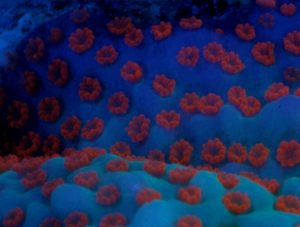





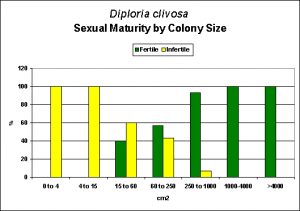


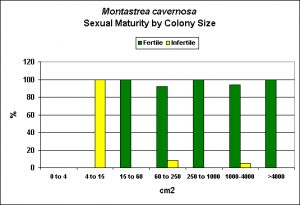





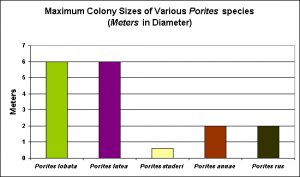




0 Comments